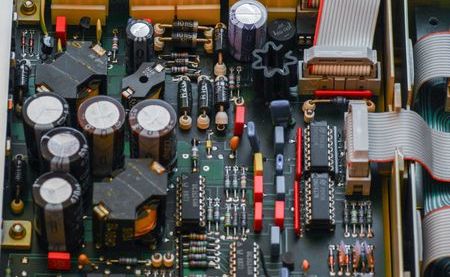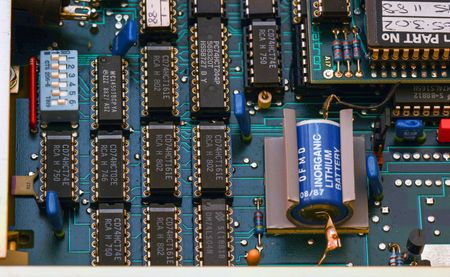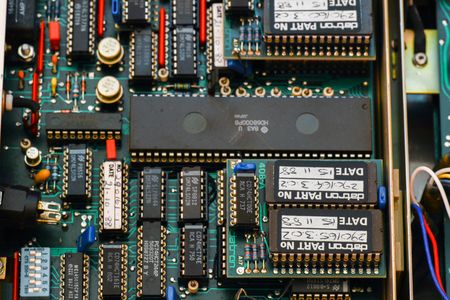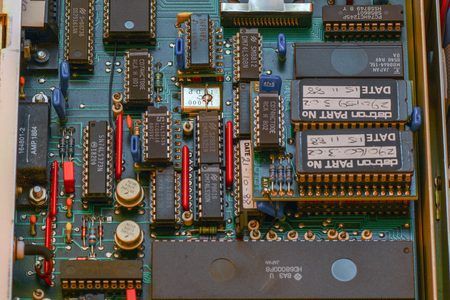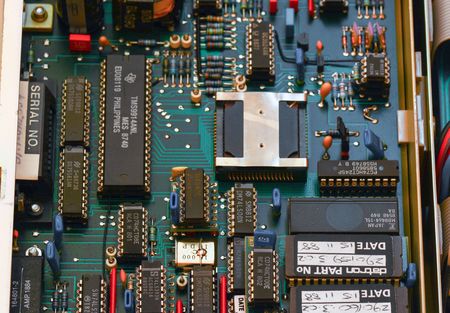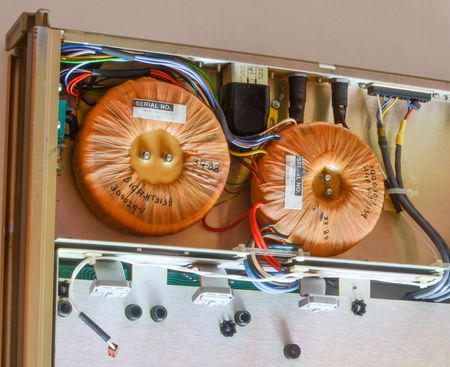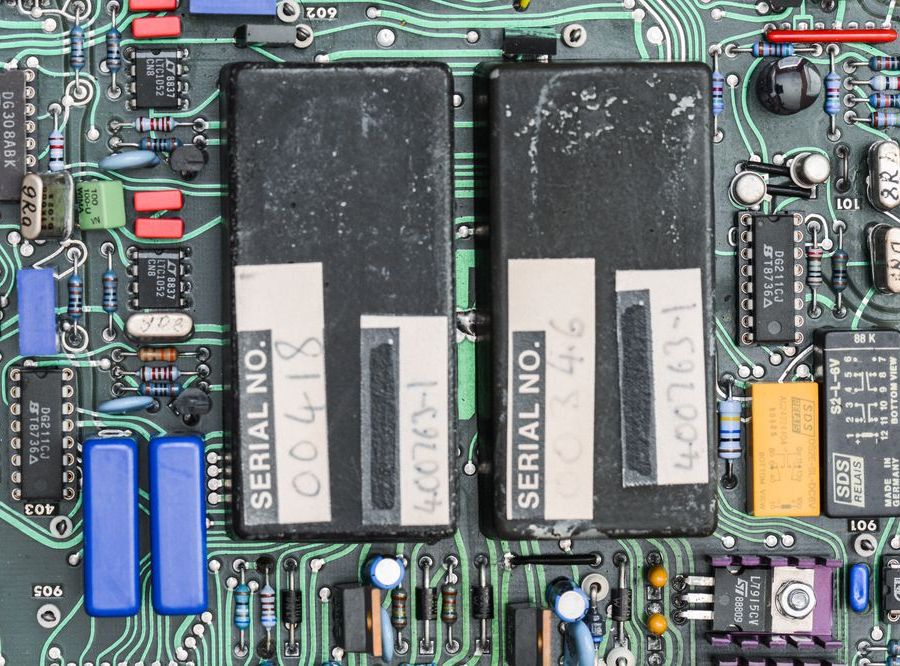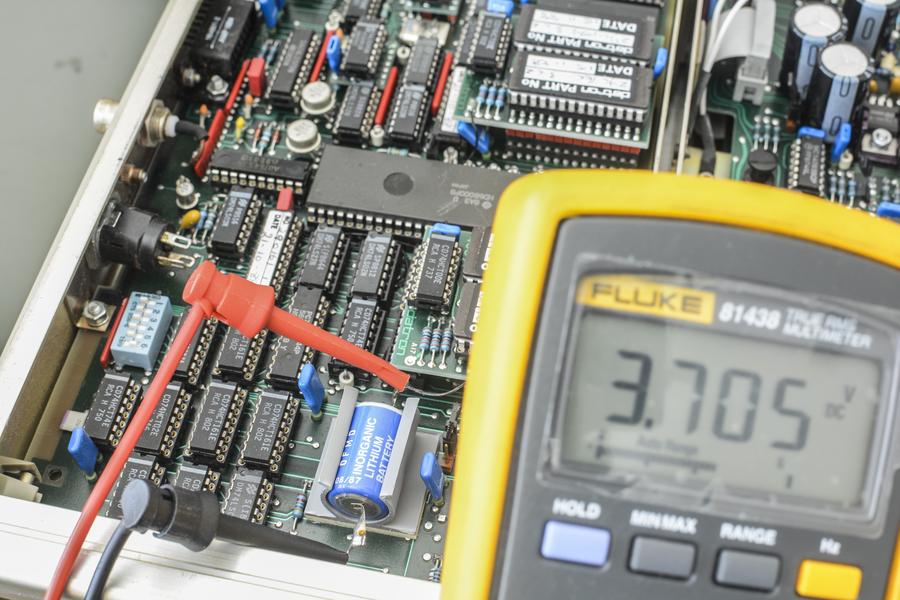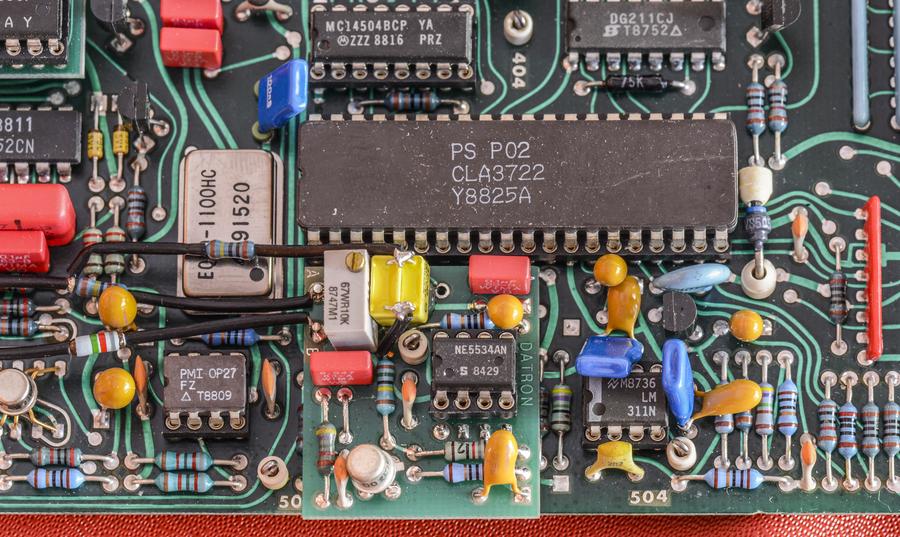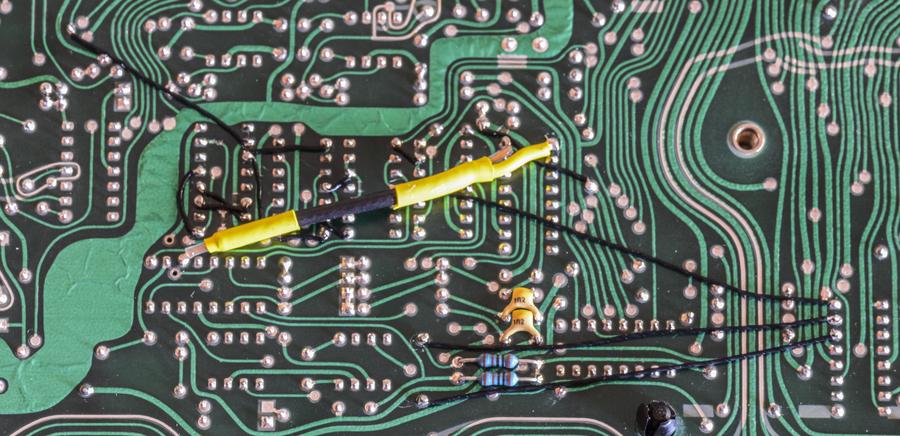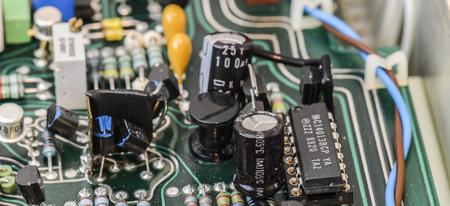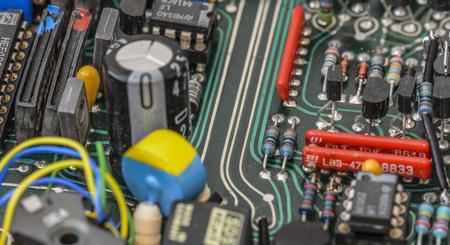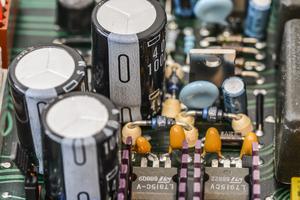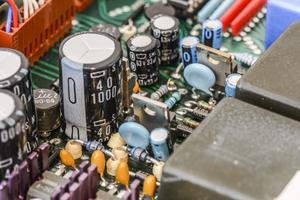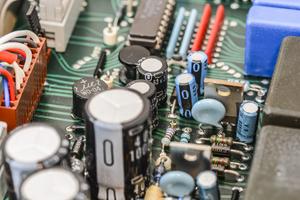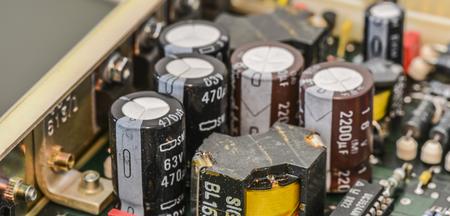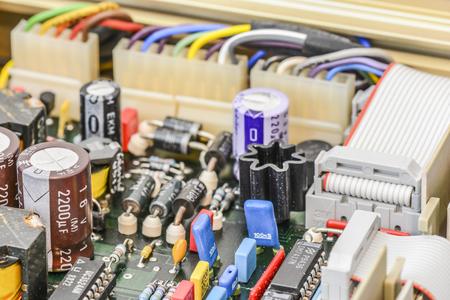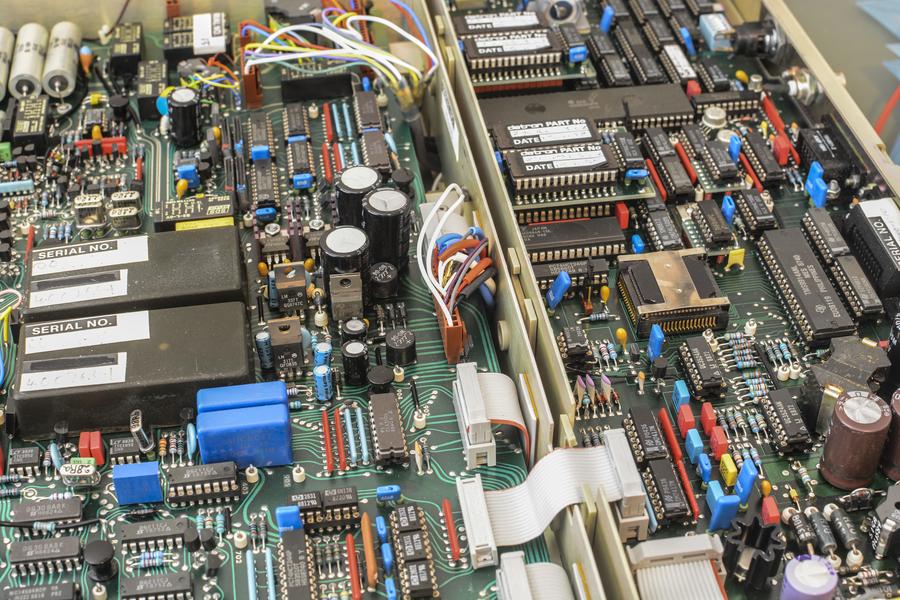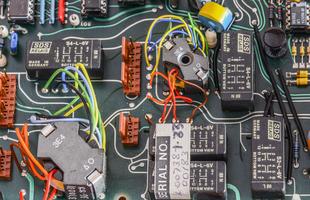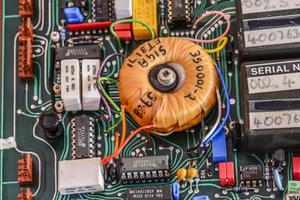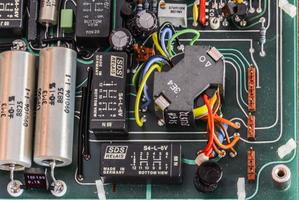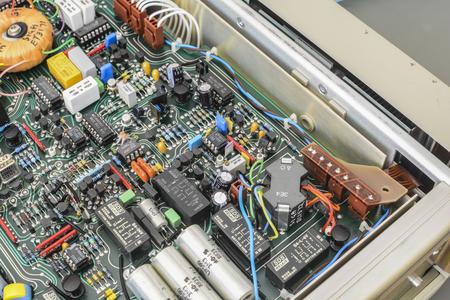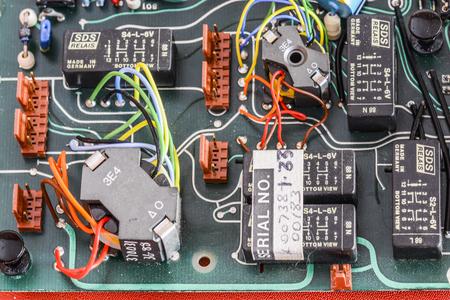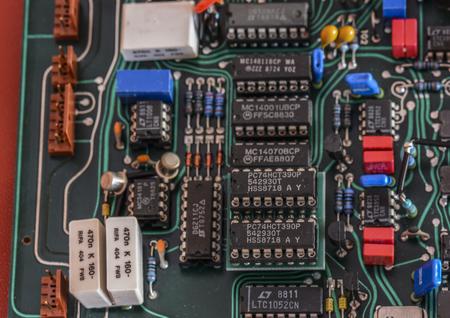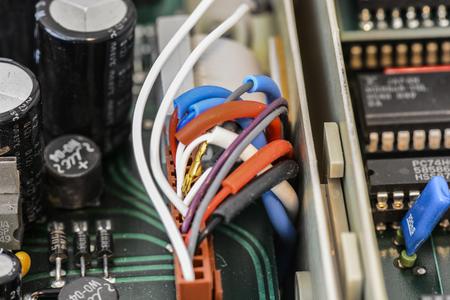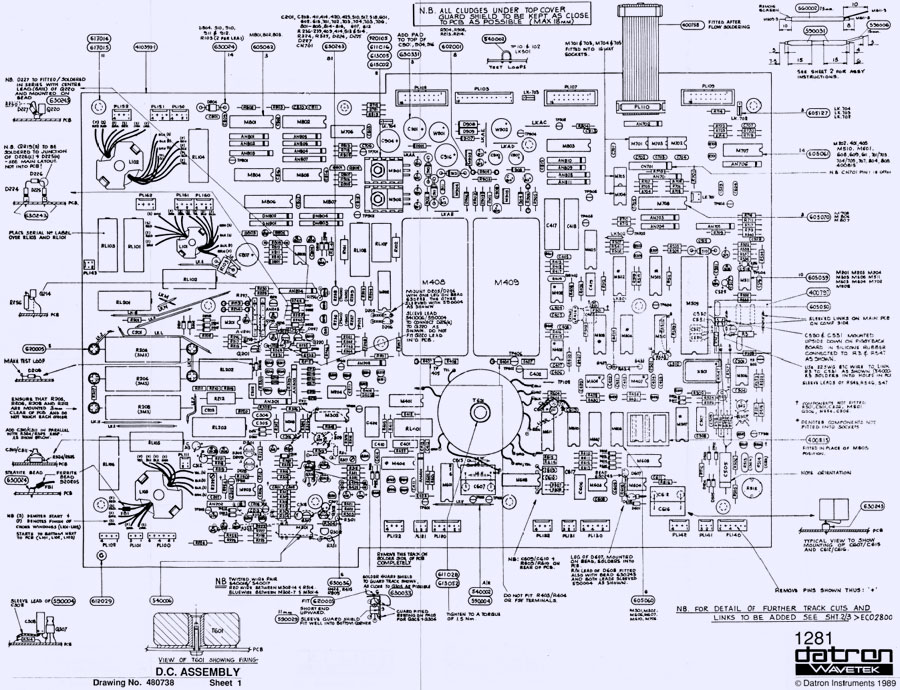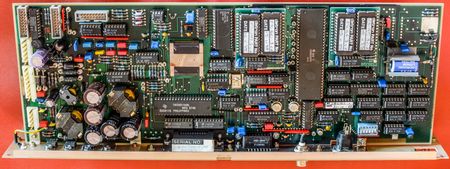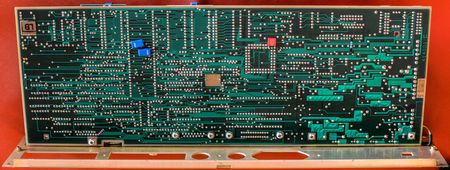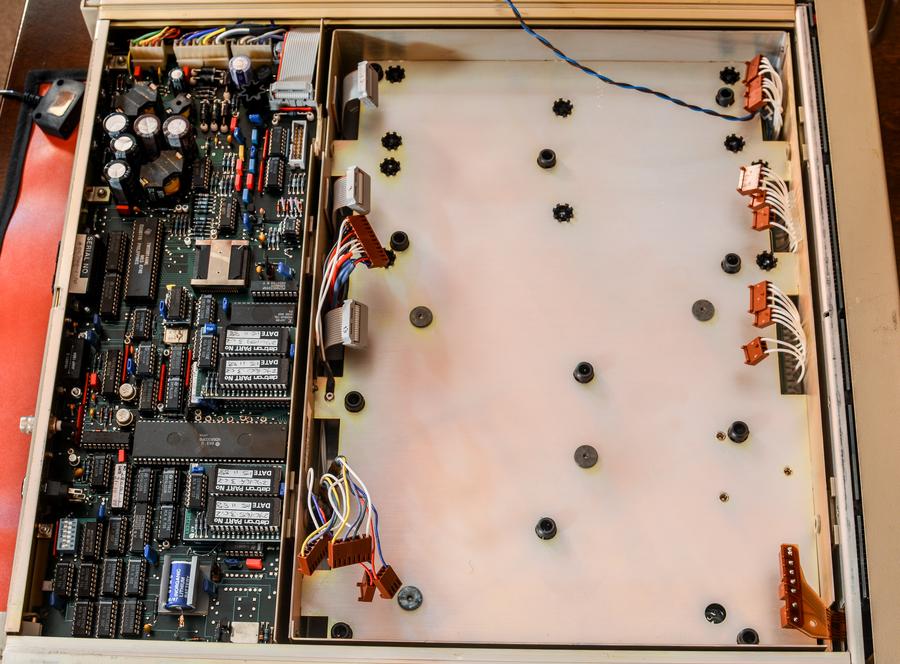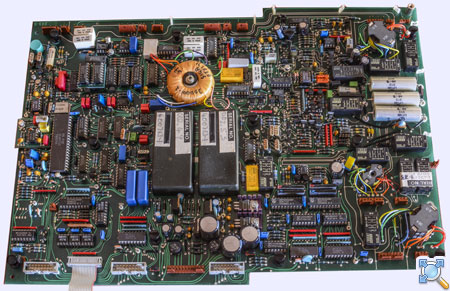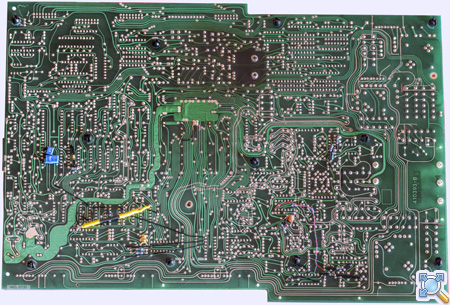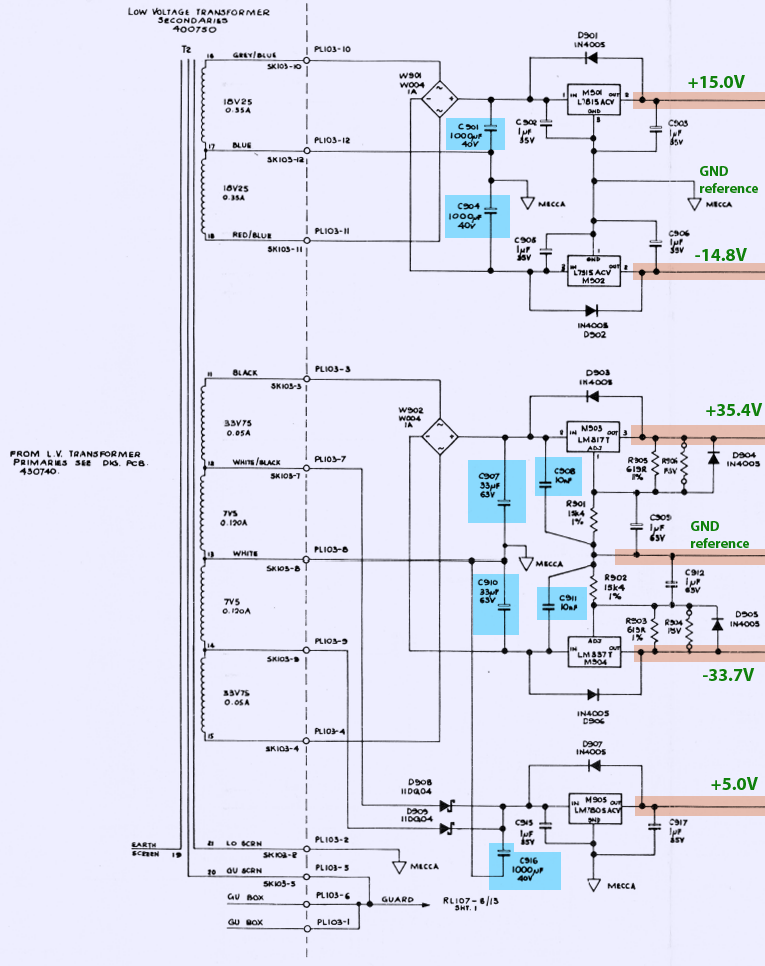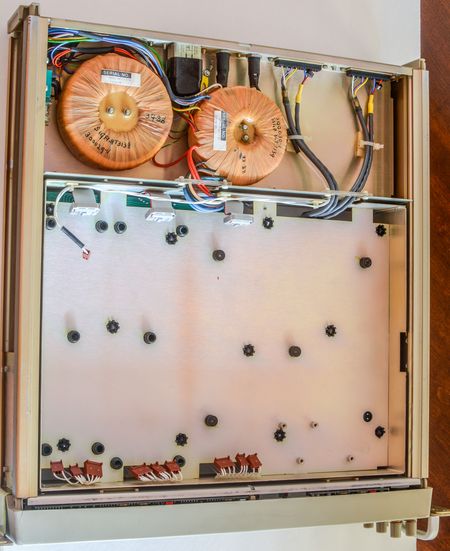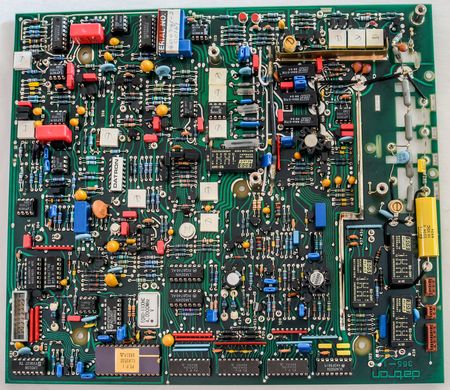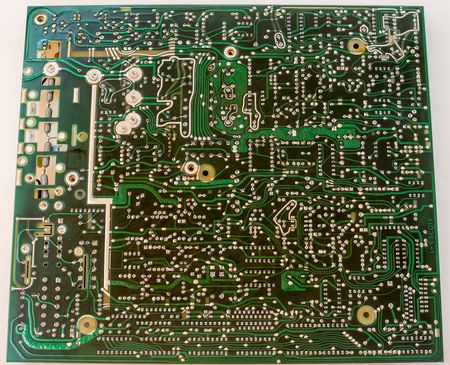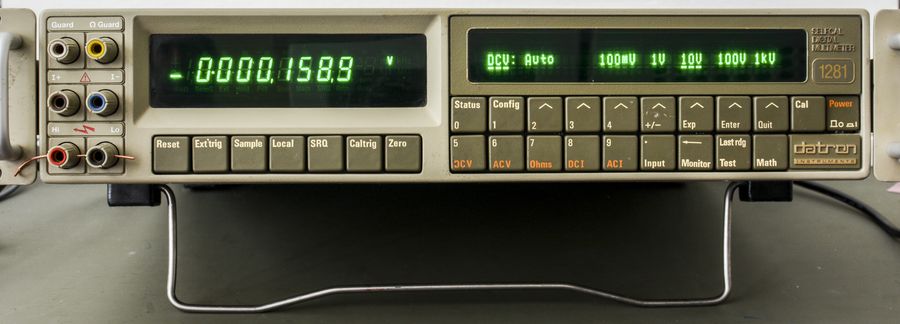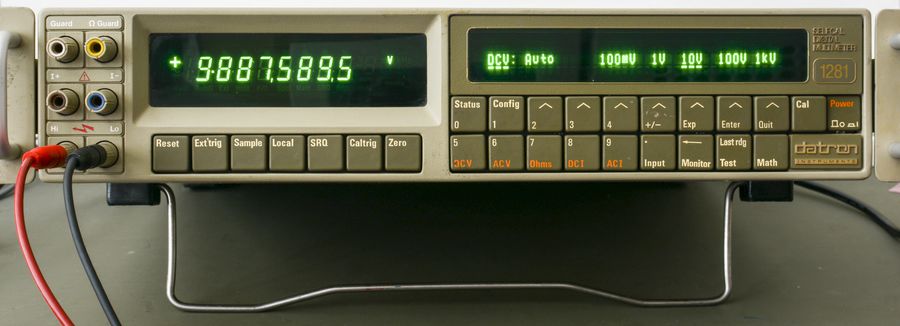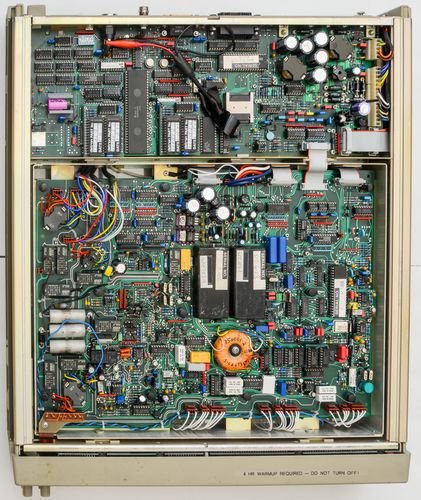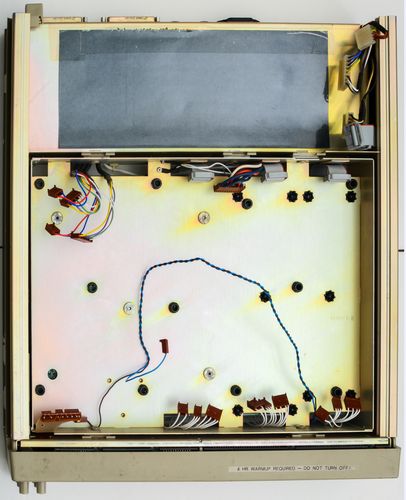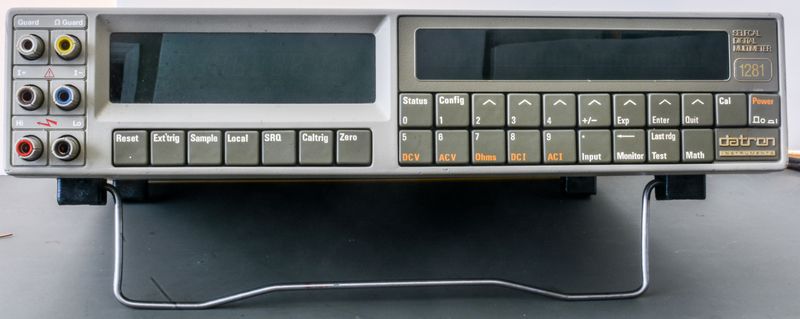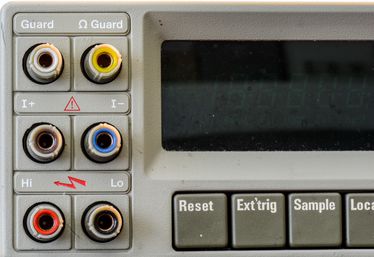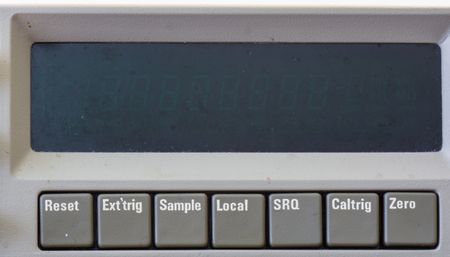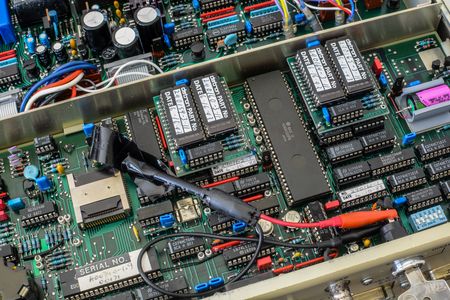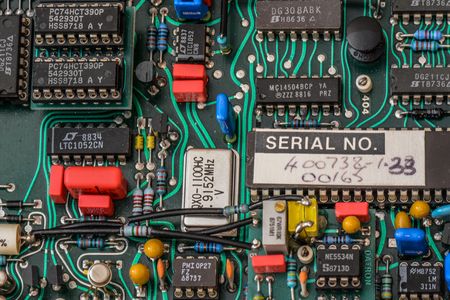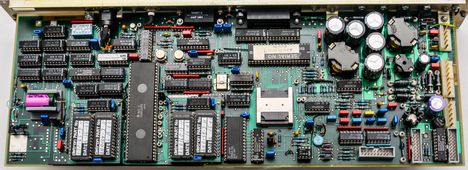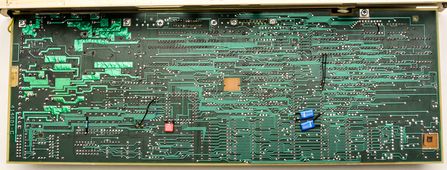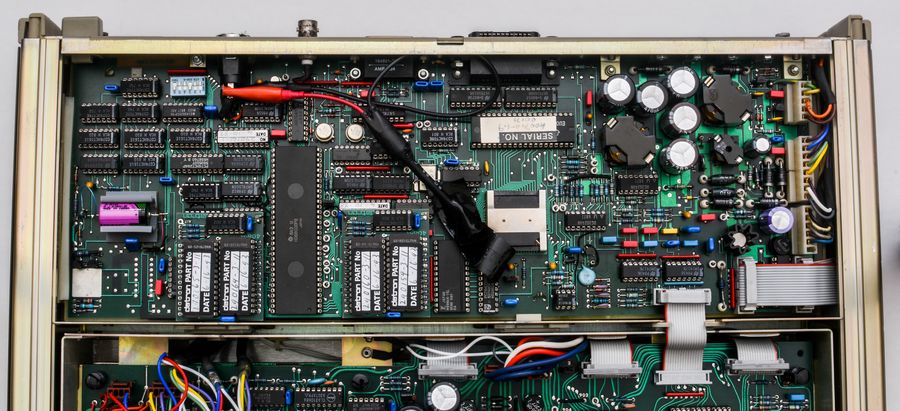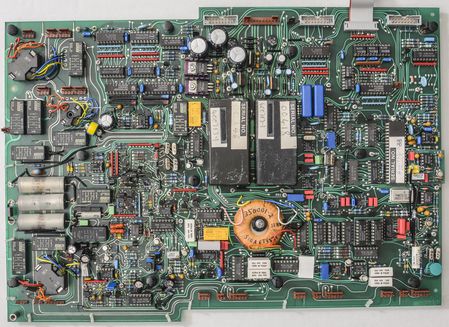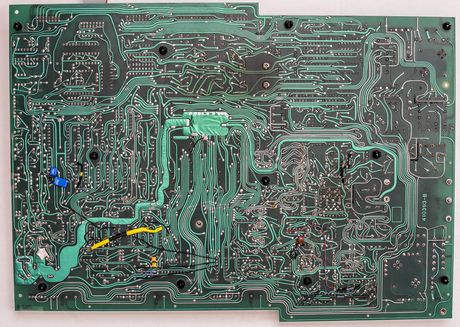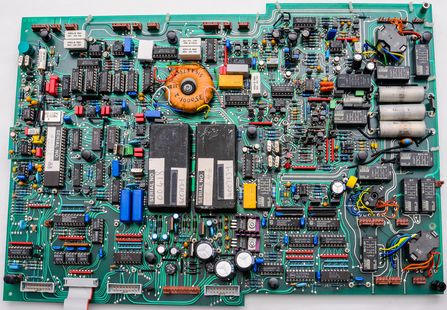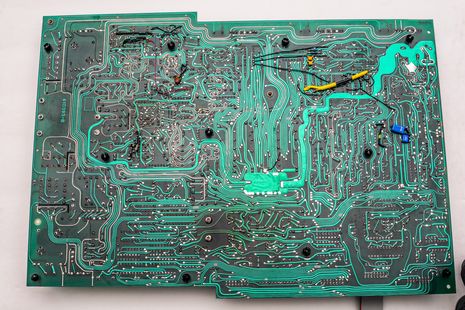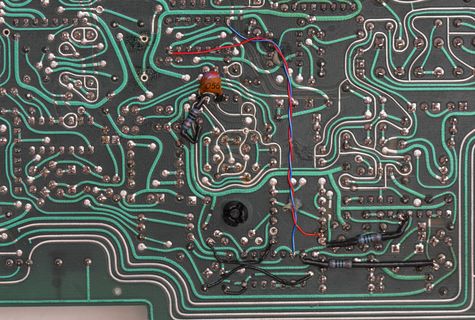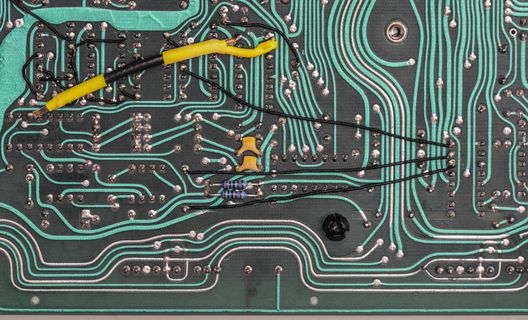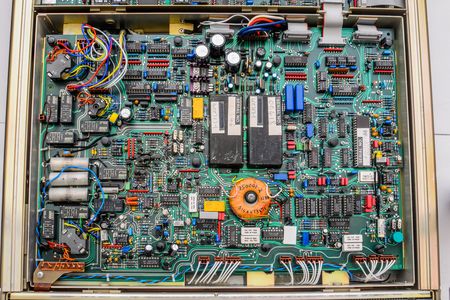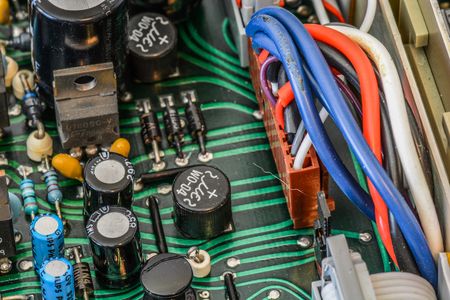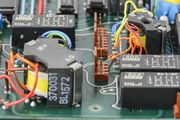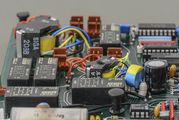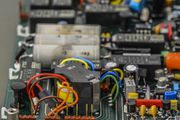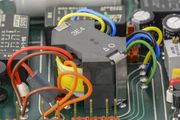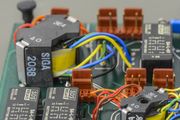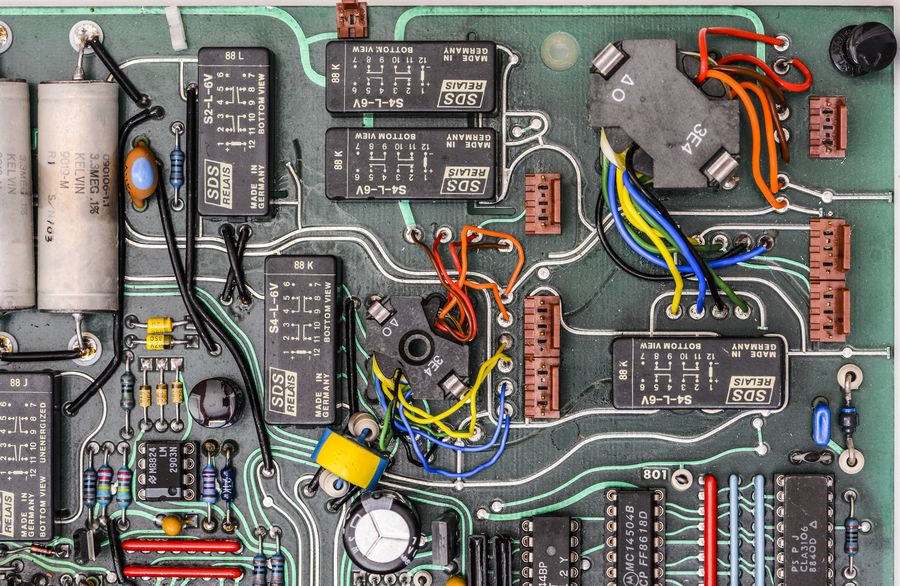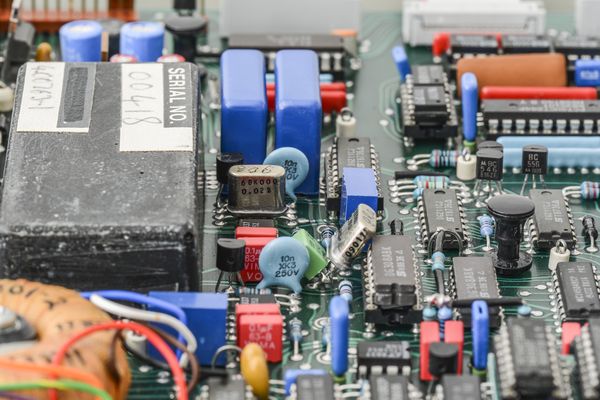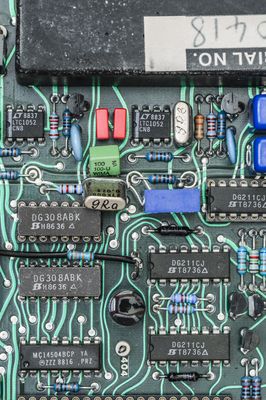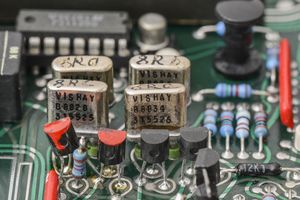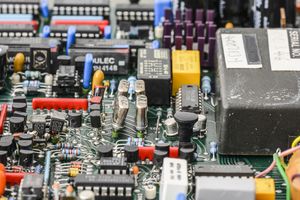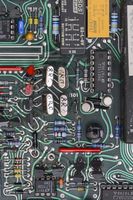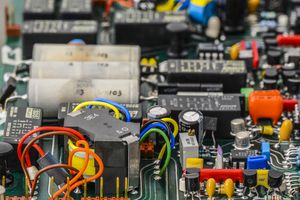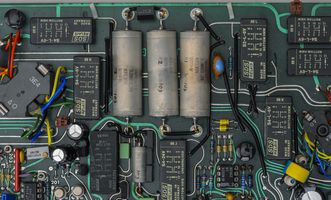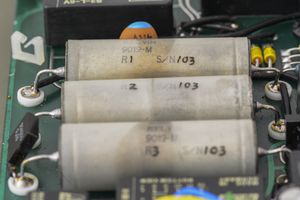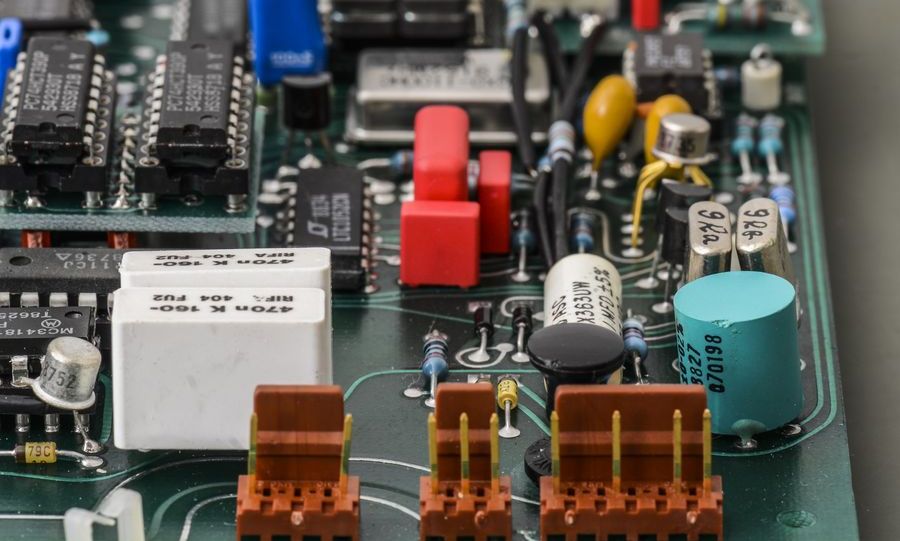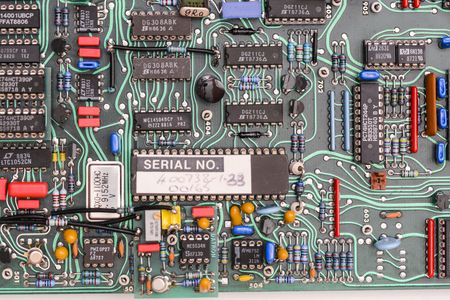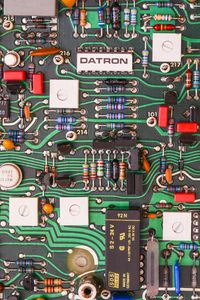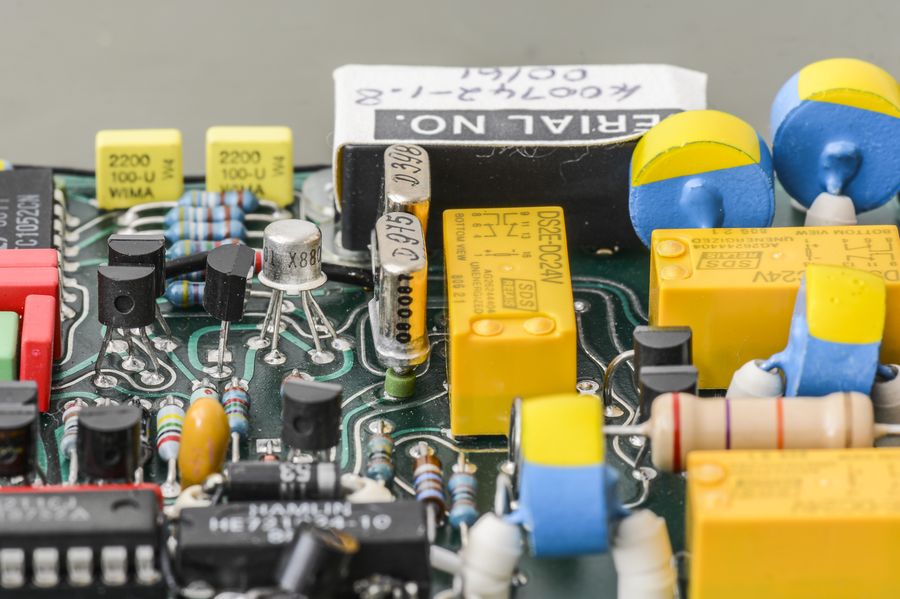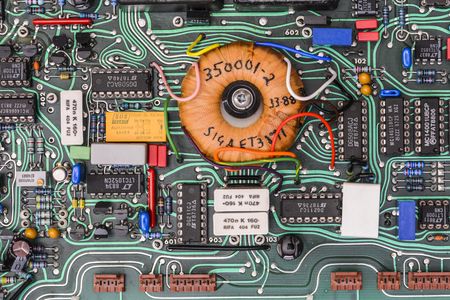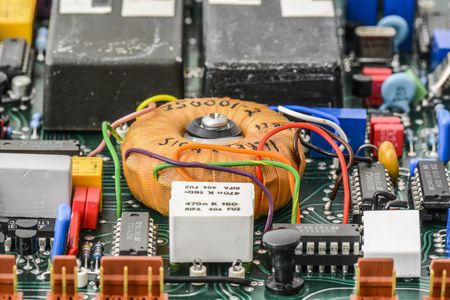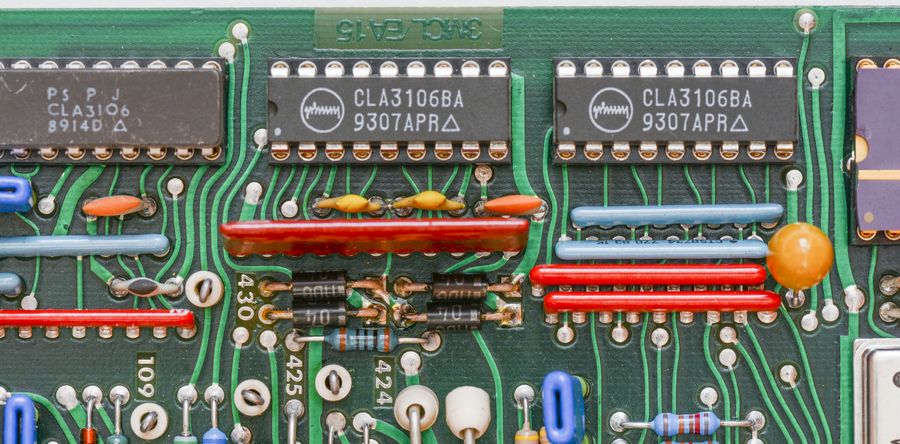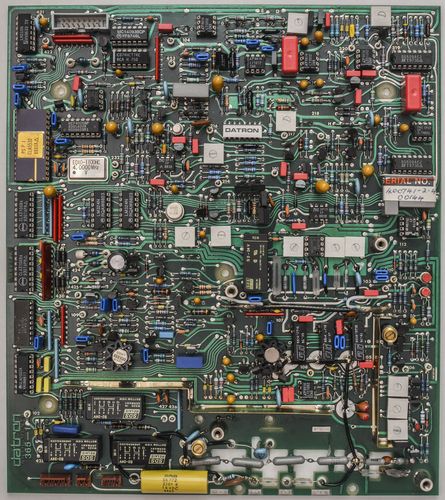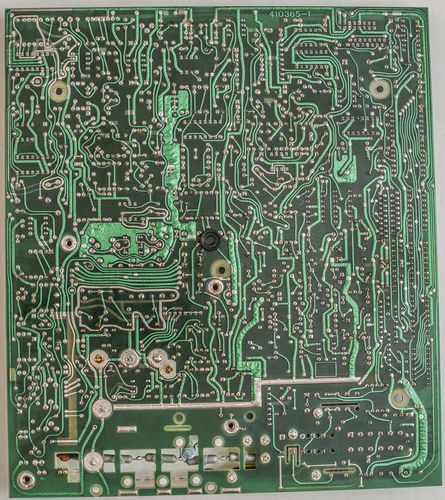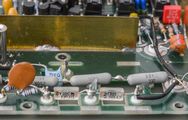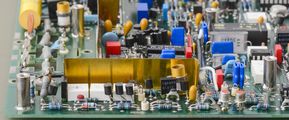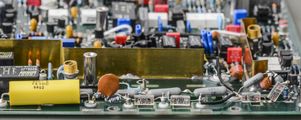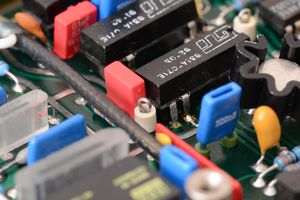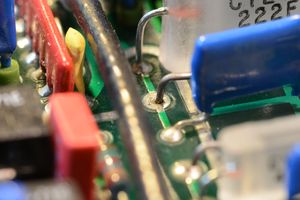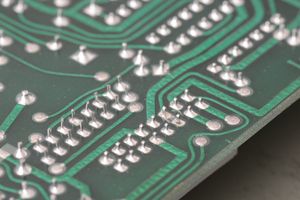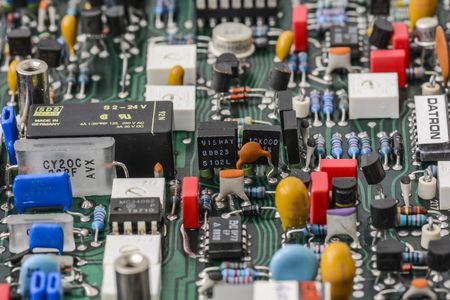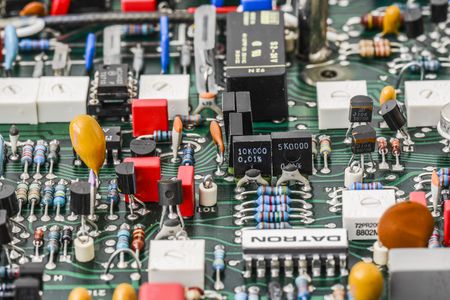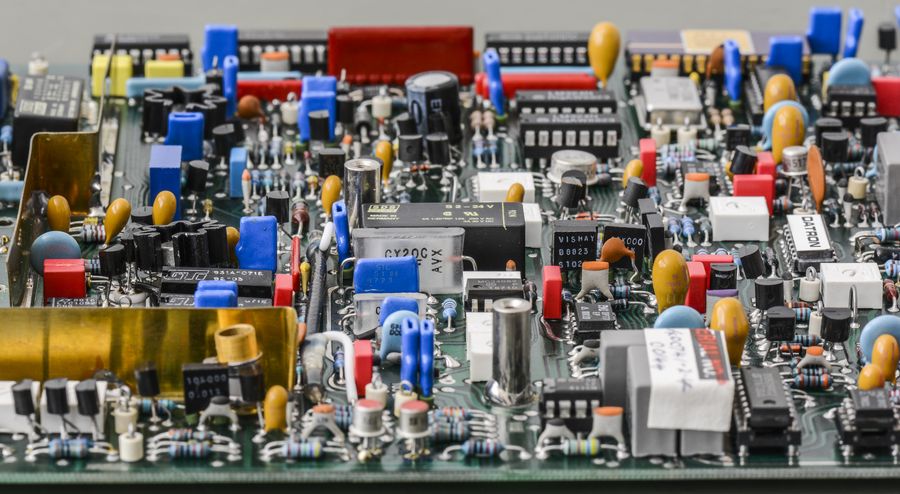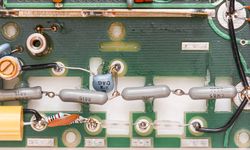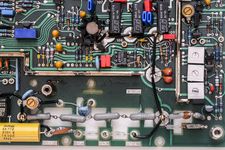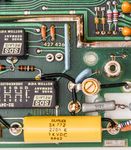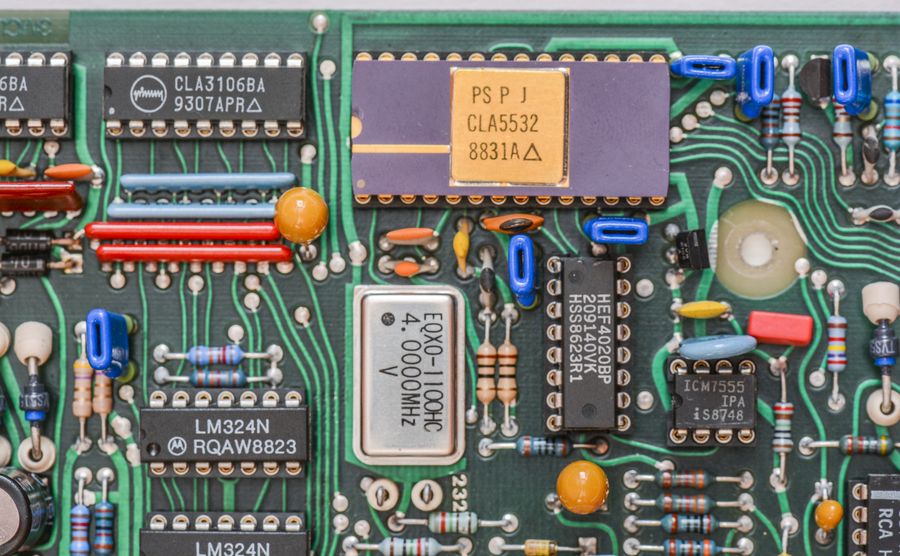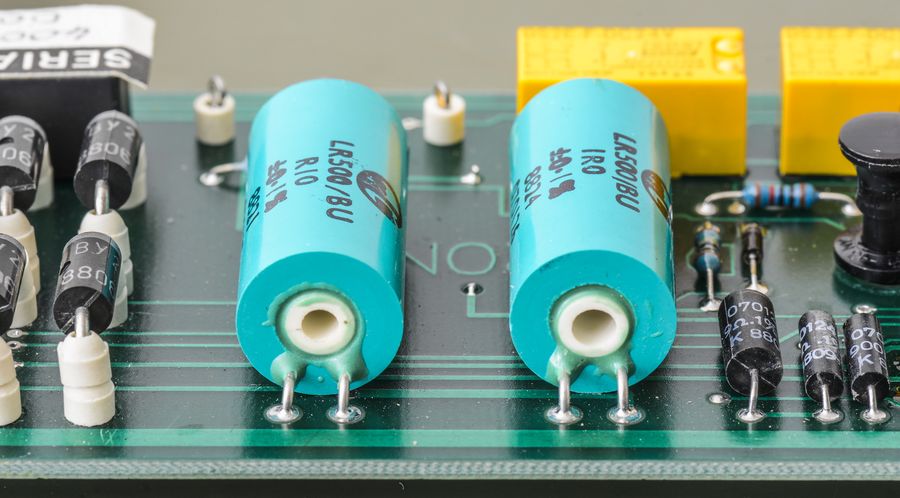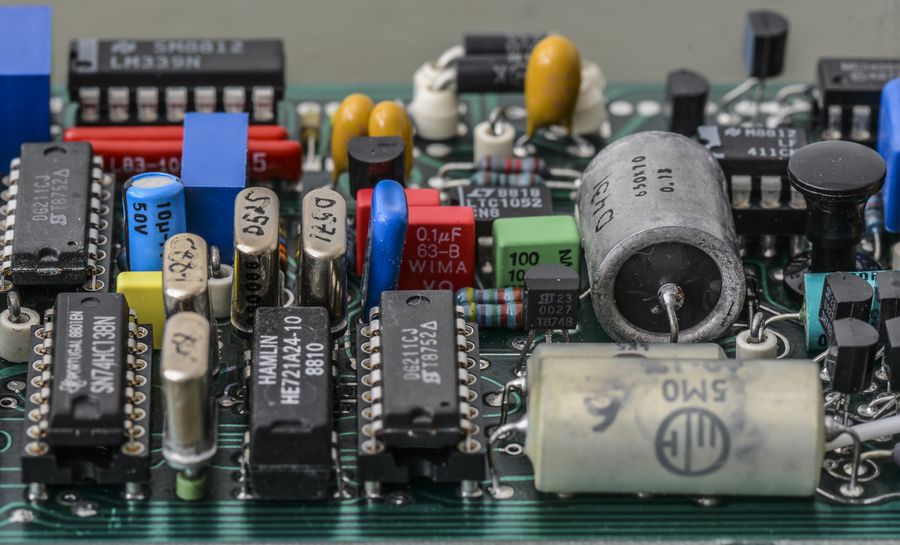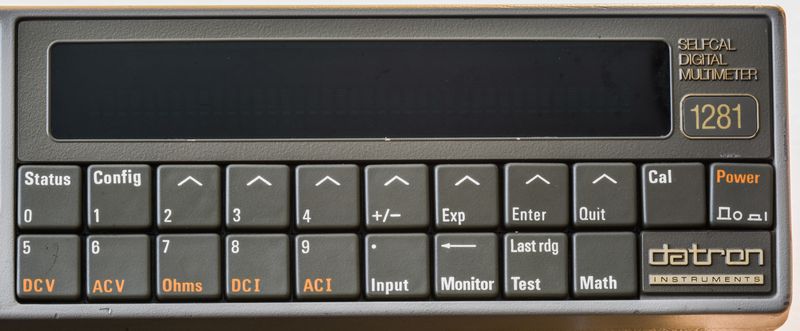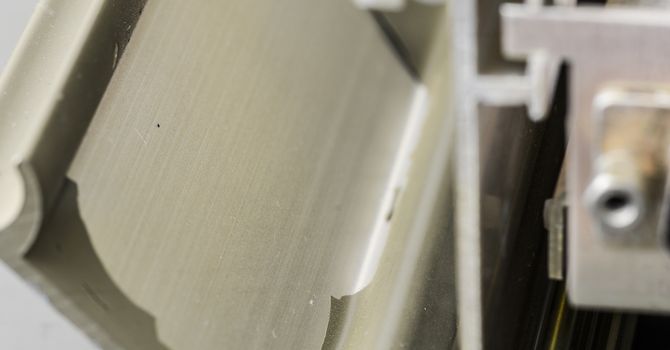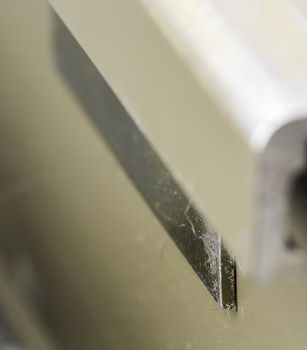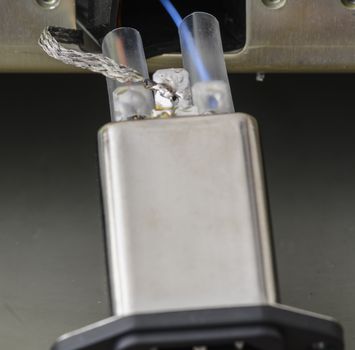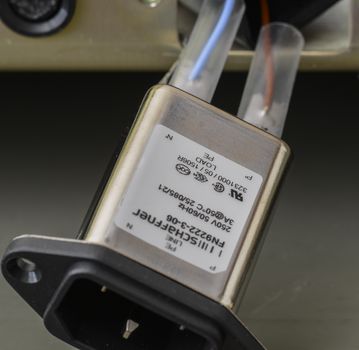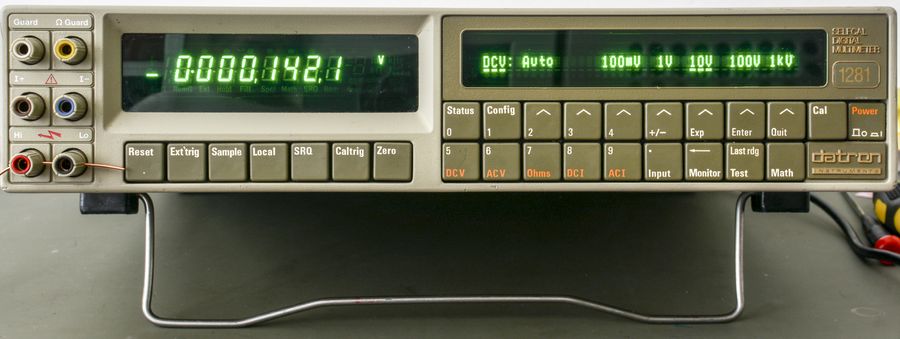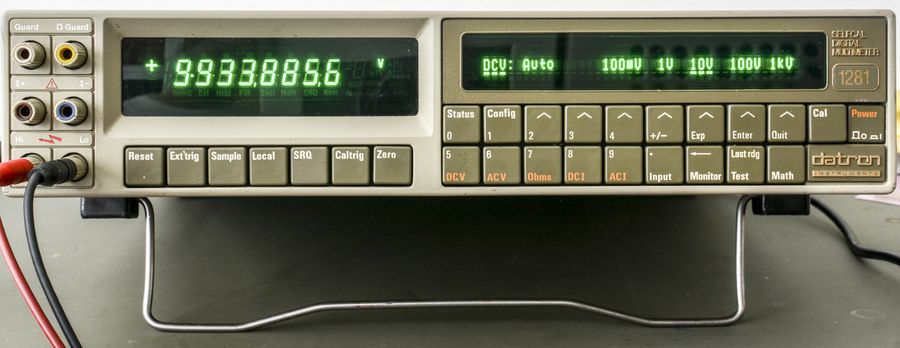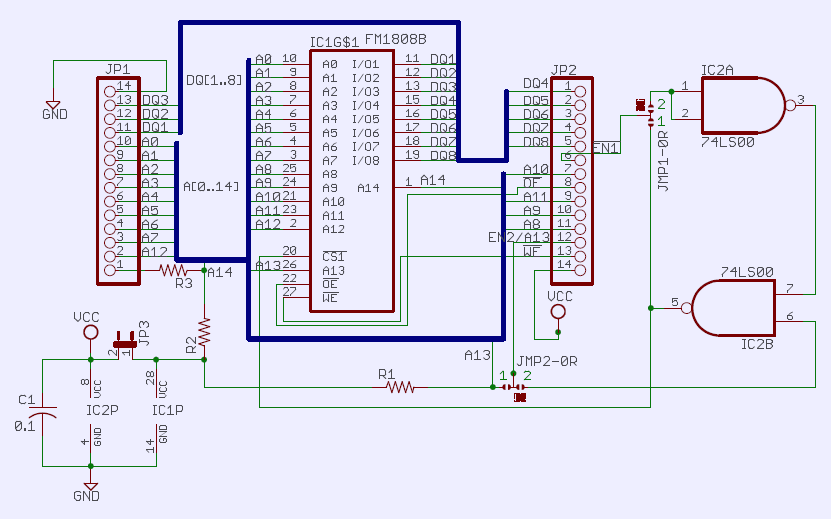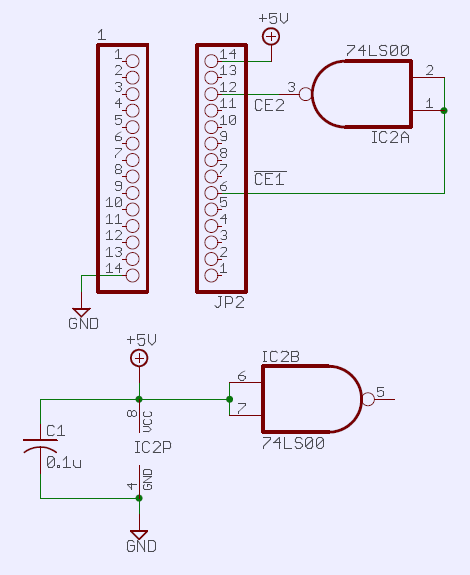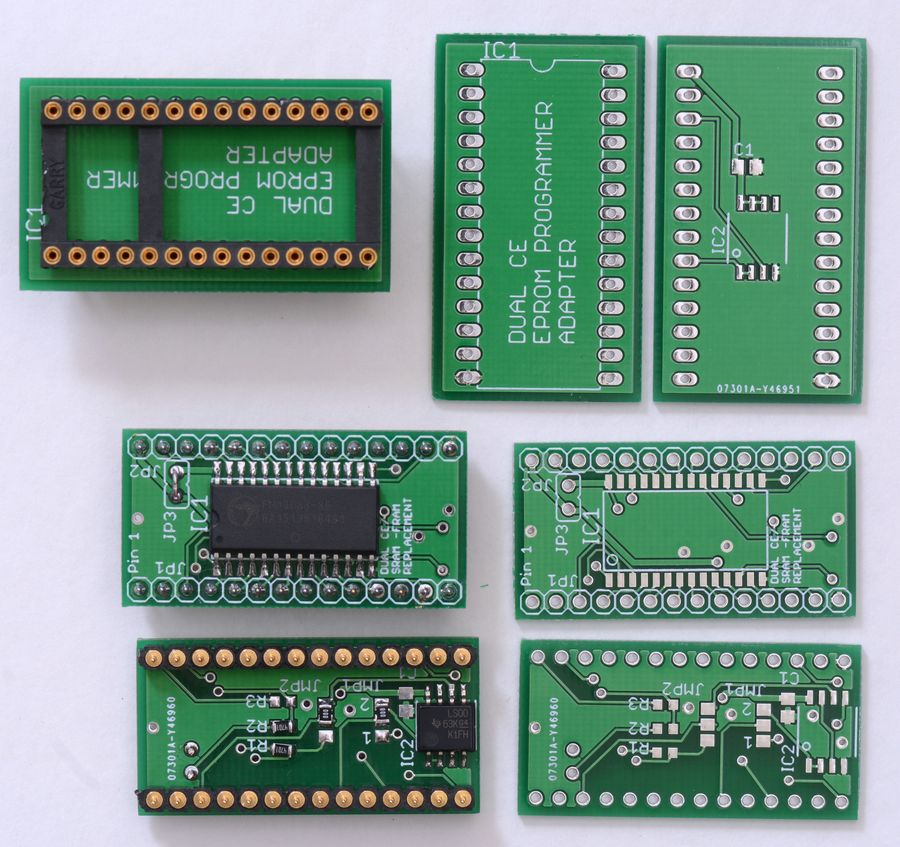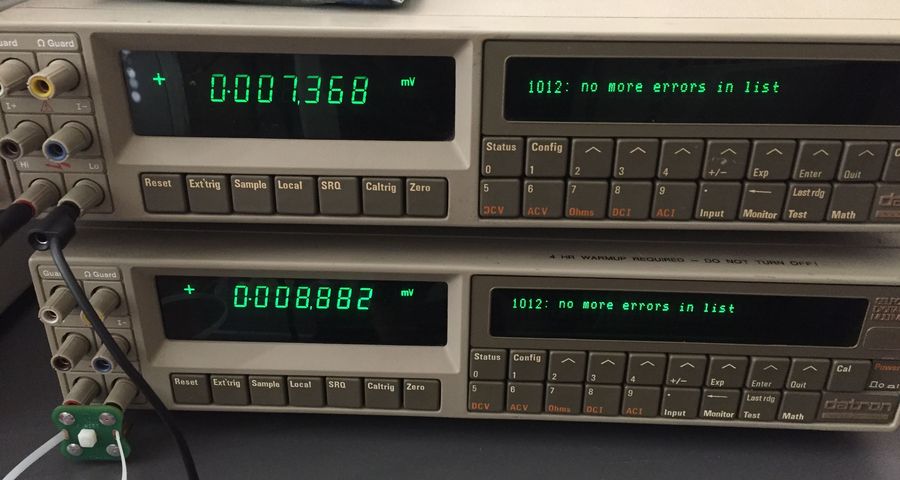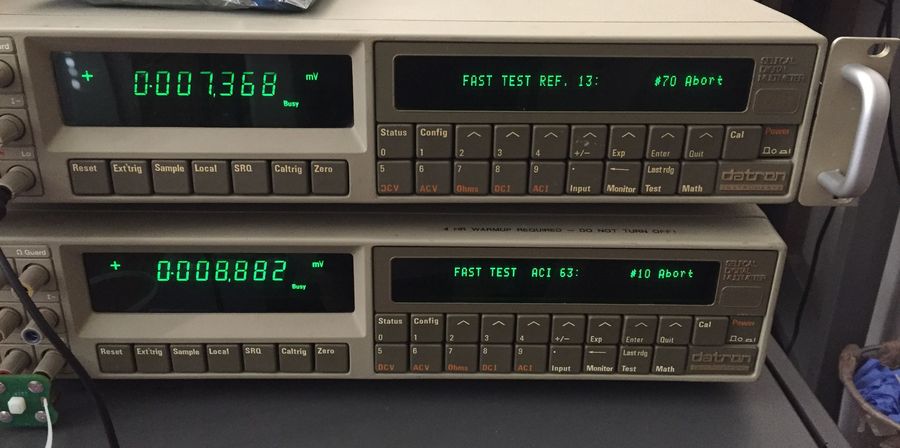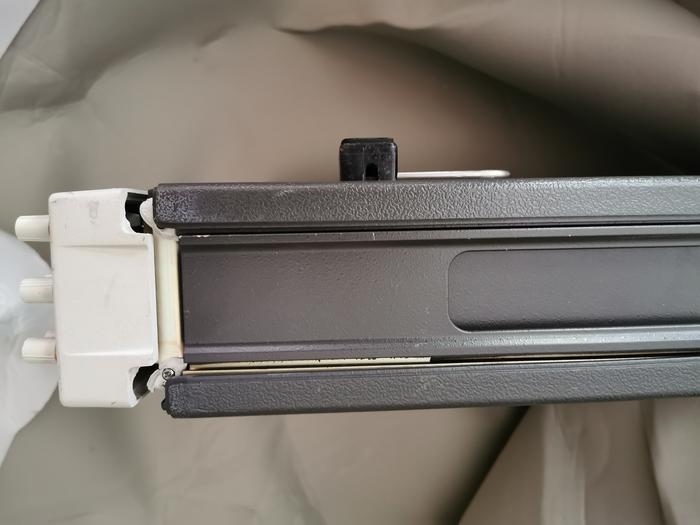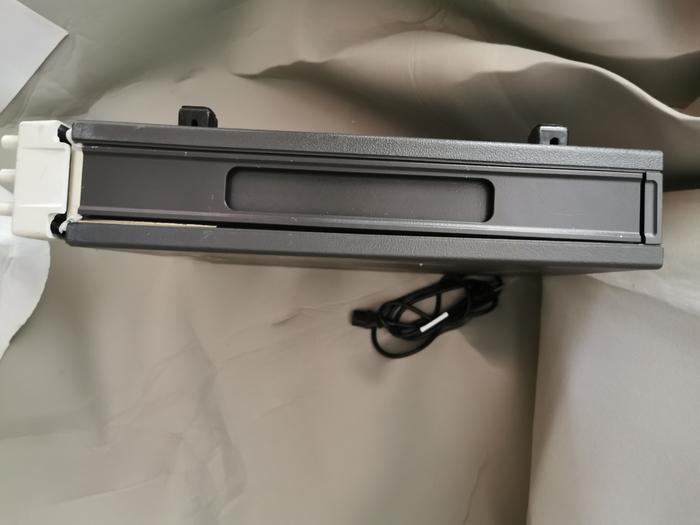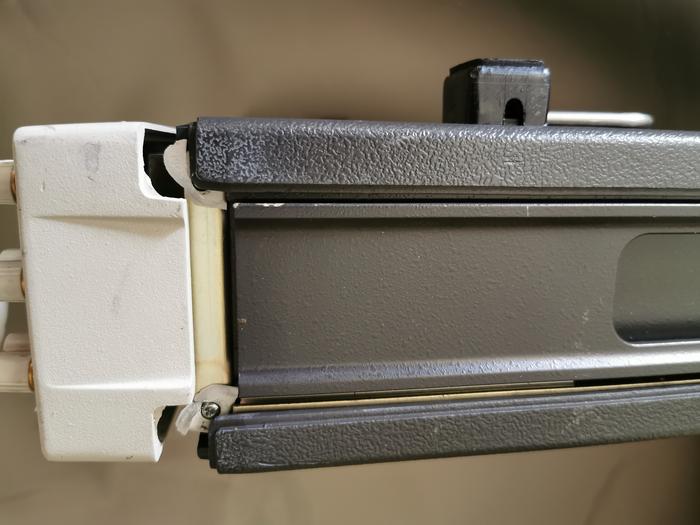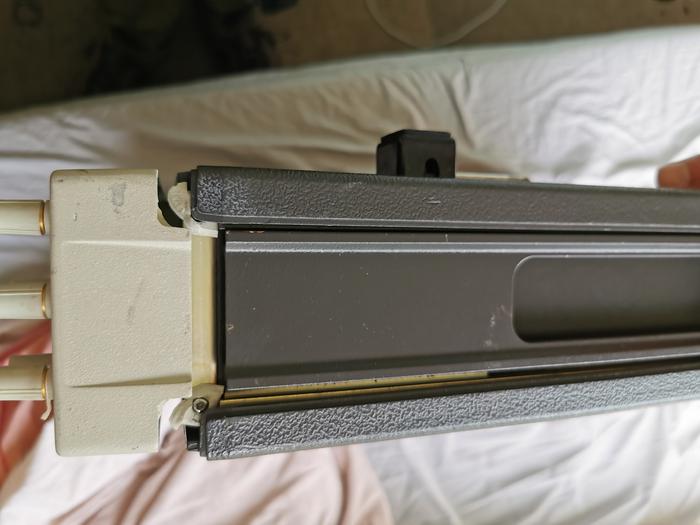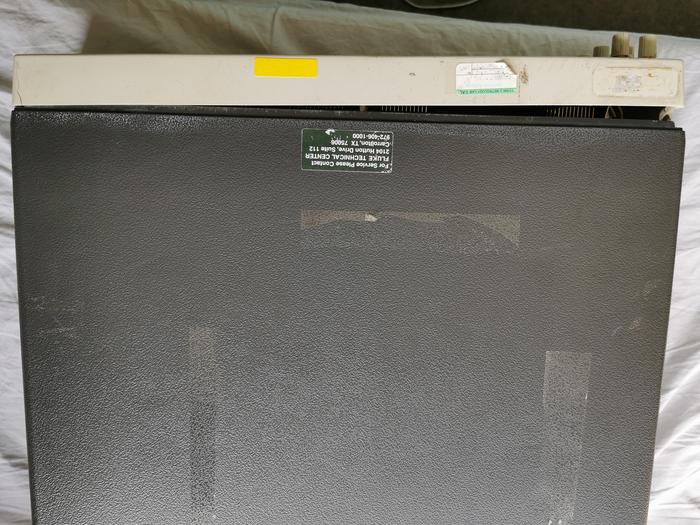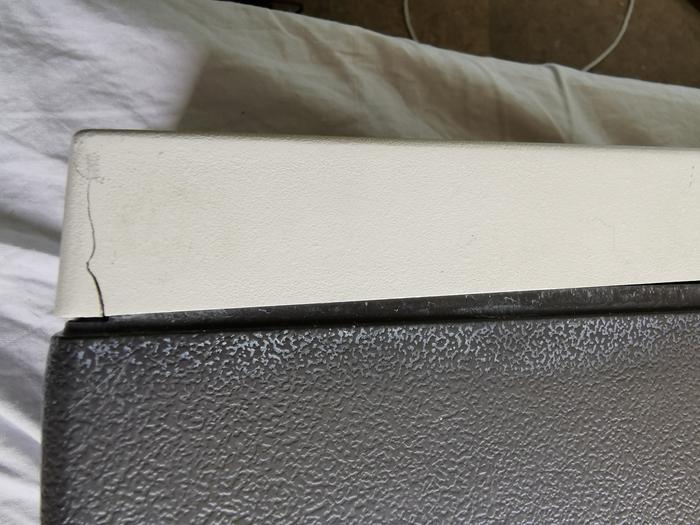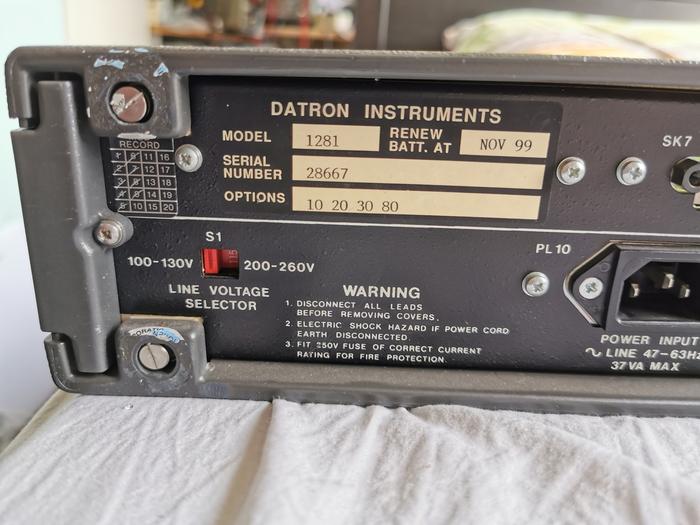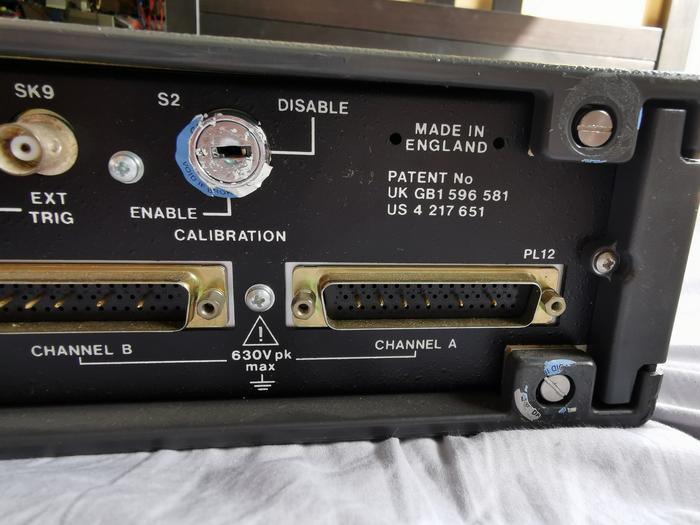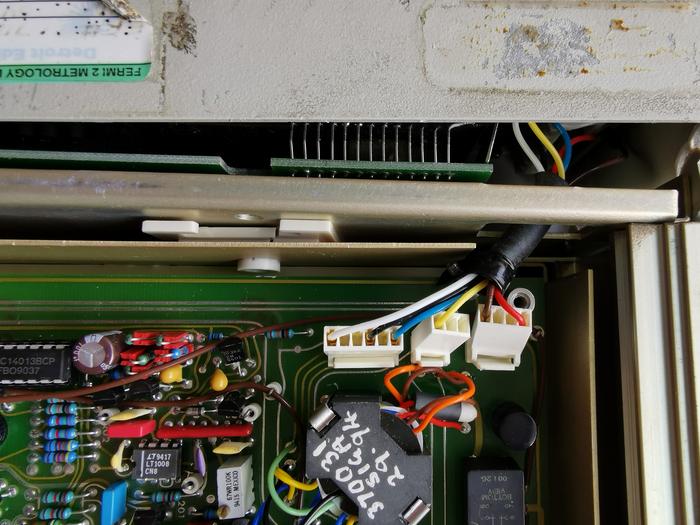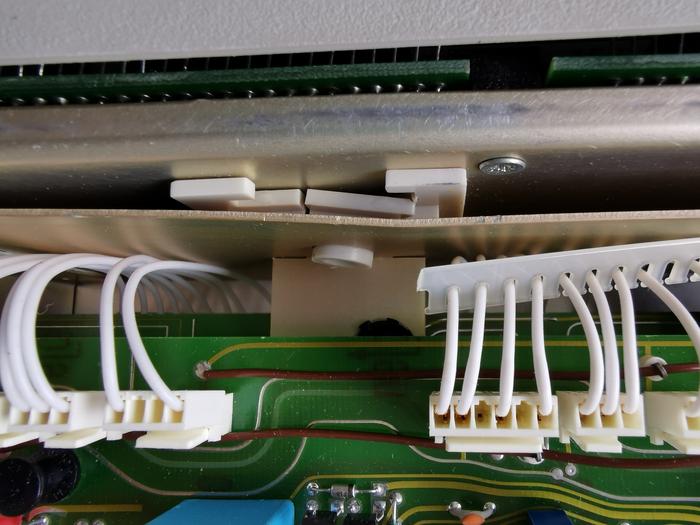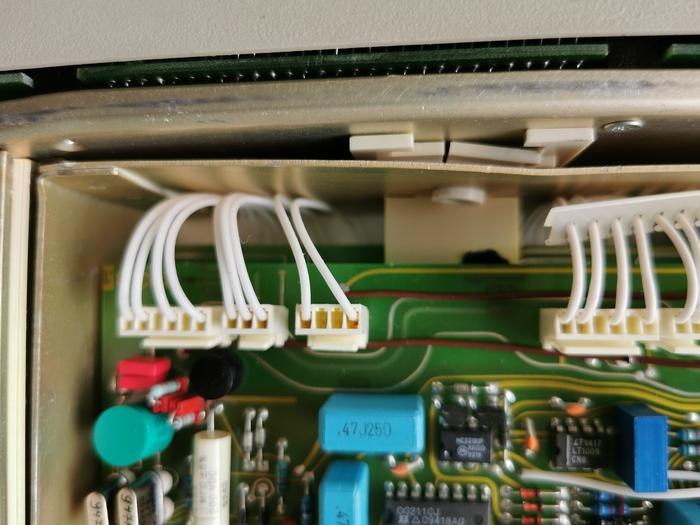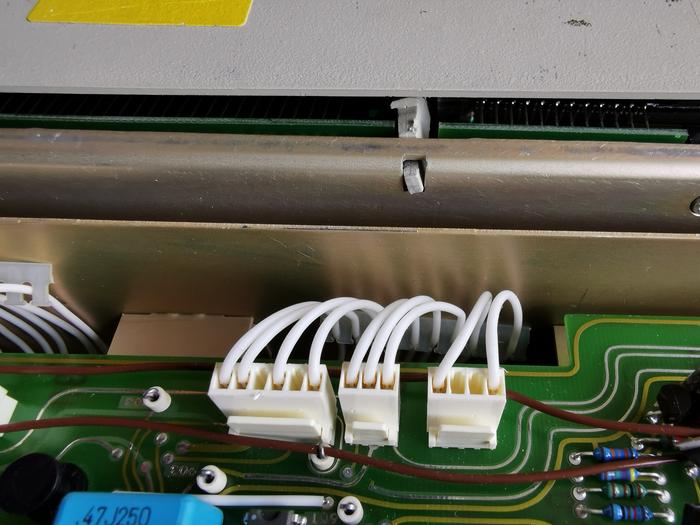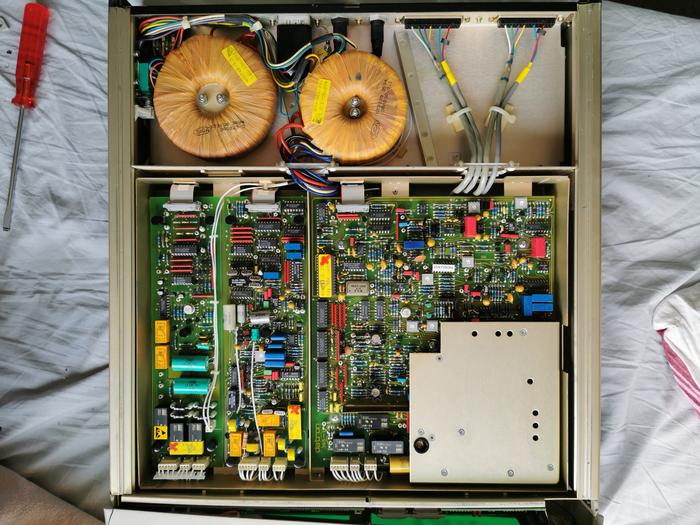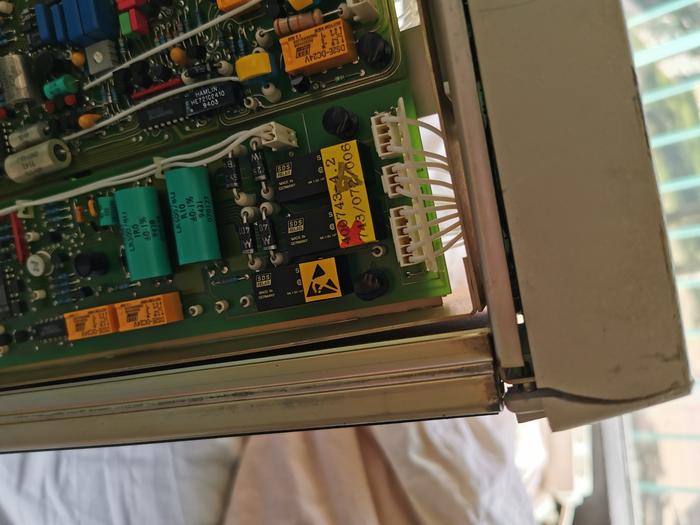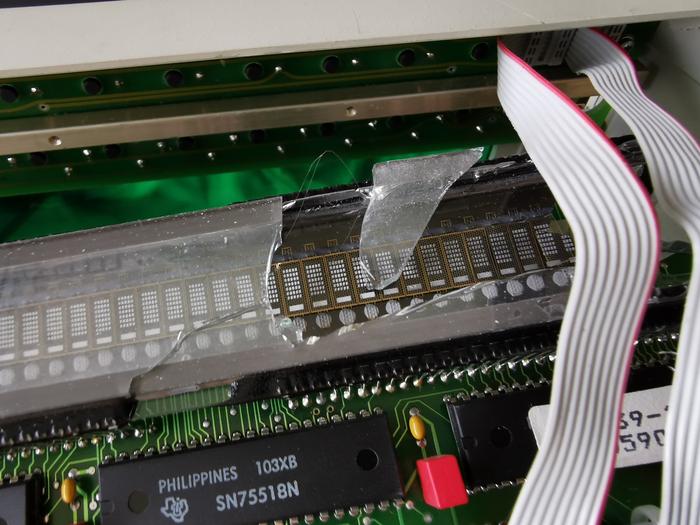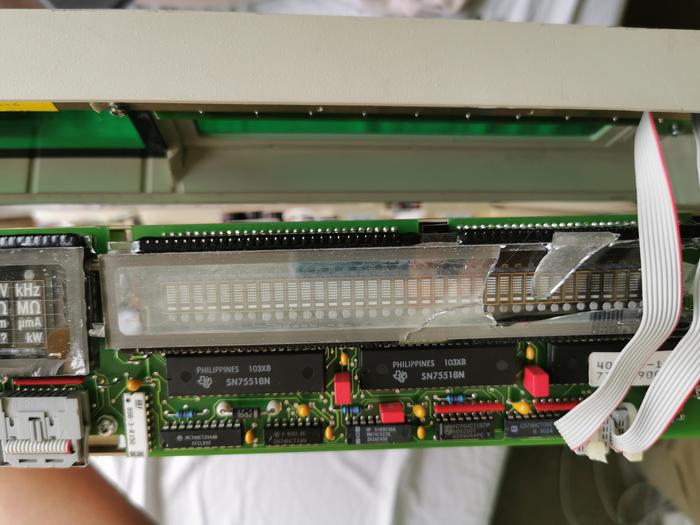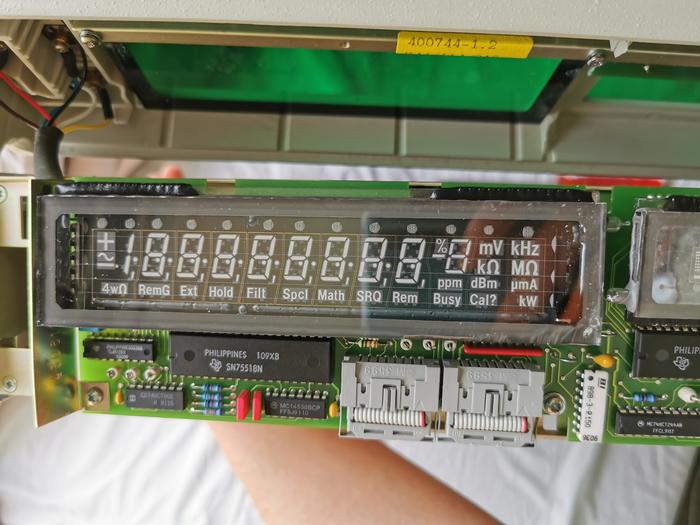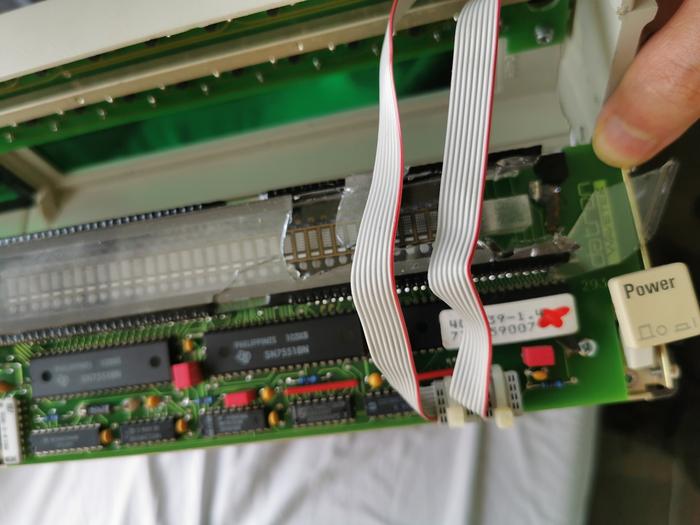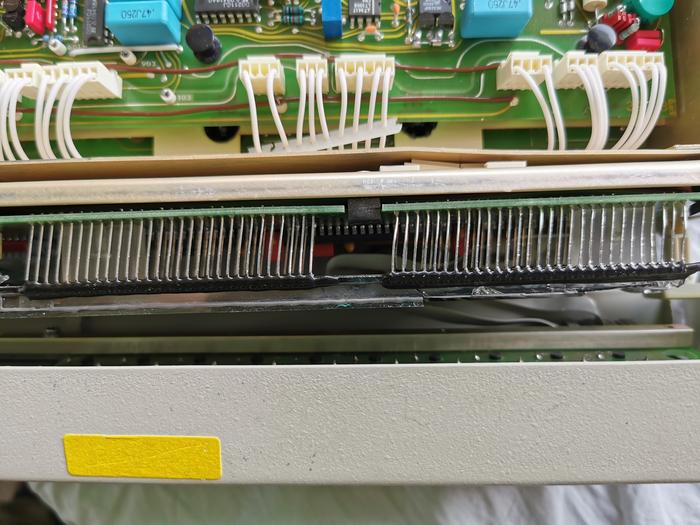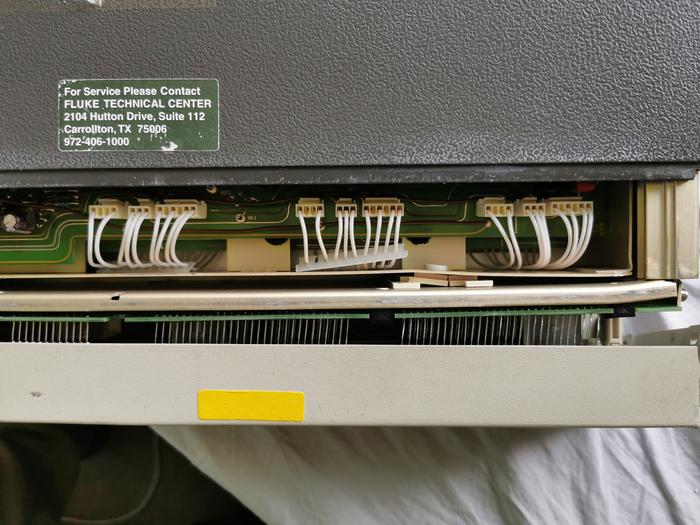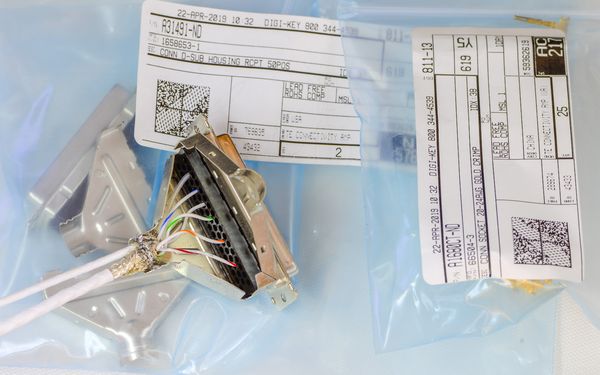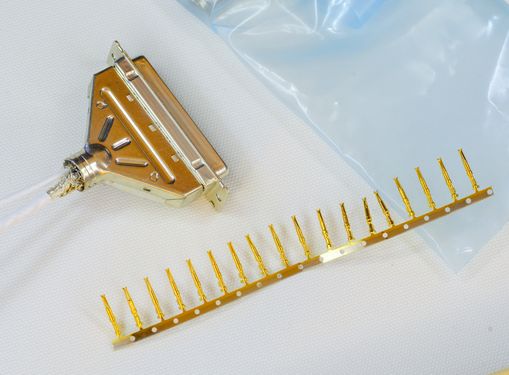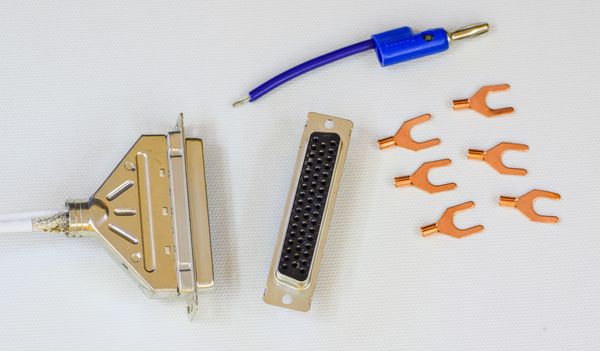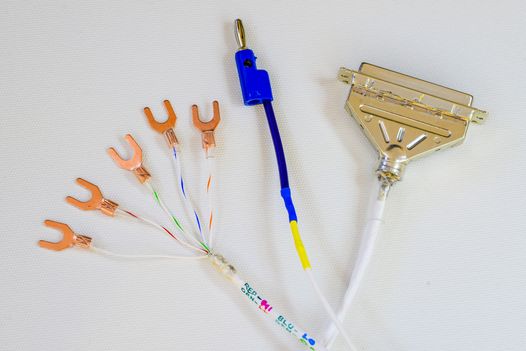Contents
- Intro
- Disclaimer
- Manual references
- Initial inspection and basic disassembly
- Repair workflow, unit #1
- Repair workflow, unit #2
- Firmware
- Custom FRAM adapters and EEPROM programmer adapter
- Other possible issues
- Tweaks and tricks
- Calibration
- Performance verification
- Restoration summary
Intro
We all know Keithley, HP/Agilent/Keysight, Tektronix, LeCroy and Fluke. But back in days, less known T&M manufacturer Datron was also known for their high-performance DMM and calibrators lineup. Datron was later acquired by Wavetek in 1987 for $15.8M. Wavetek was still manufacturing original Datron DMMs and calibrators, and eventually sold it’s T&M division to Fluke in 2000 for $40M. As of today there is no service provided for obsolete lineup, but lot of knowledge and technology from Datron was used in Fluke’s high-performance products, such as 8508A 8½ DMM and obsoleted now 7001 DC standard.
Having all that said, 1271 and 1281 are still welcome instrument in many labs, with 8½-digit resolution and metrology grade performance. Common rival for these system multimeters is well known HP 3458A and Keithley 2002. These Datron DMMs are still going on secondary market, for prices range around USD $2000.
This article will cover two different unit, with second generation Wavetek-branded logo, produced somewhen in 1992. These were purchased as “used”. There are not many DMMs of this performance level on the market even today, so it will be interesting to fix and see what these are capable by today’s standards. Below is table of all 8½-digit DMMs for your reference
| Manufacturer | Model | Type | Status | DCV accuracy | Resistance accuracy | DCI accuracy |
|---|---|---|---|---|---|---|
| Additel | 286 | Datalogger with DMM | Current model | |||
| Advantest/ADCMT | R6581D | DMM | No longer available for sale | ±5ppm + ±0.2ppm | ±8ppm + ±0.2ppm | ±20ppm + ±20ppm |
| Datron | 1281/1271 | DMM | No longer available for sale | ±3.1ppm | ±6ppm | ±25ppm |
| HP/Agilent/Keysight | 3458A | DMM | Current model | |||
| Fluke | 8508A | DMM | Obsolete model | |||
| Fluke | 8558A | DMM | Current model | |||
| Fluke | 8588A | DMM | Current model | |||
| Keithley | 2002 | DMM | Current model | |||
| PREMA | 6048 | DMM | No longer available for sale | ±5ppm + ± 1ppm | ±7ppm + ±5ppm | ±30ppm + ±10ppm |
| Solartron | 7081 | DMM | No longer available for sale | |||
| Transmille | 8080 | DMM | Current model | |||
| Transmille | 8081 | DMM/Electrometer | Current model | |||
| Transmille | 8881 | DMM | Current model | |||
| ZIP Nauchpribor KM300 | KM300 | DCV/Res/Calibrator |
Table 1: 8½-digit DMMs
HP and Keithley we already looked at on pages of this site, so it’s time for Wavetek-Datron.
So what’s special about this DMM? Let’s take a look on few key specifications for Datron 1281. Detailed specifications are presented later in manuals section of this article.
| Function | Ranges | Accuracy |
|---|---|---|
| DC Voltage | 0 to ±1000V | Best 1 Year Specification: ±3.1 ppm |
| AC Voltage | 100 mV to 1000V @ 40 Hz to 1 MHz | Best 1 Year Specification: ±60 ppm |
| DC Current | 0 to ±2A | Best 1 Year Specification: ±25 ppm |
| AC Current | 100 mA to 2A @ 10 Hz to 5 kHz | Best 1 Year Specification: ±200 ppm |
| Resistance | 10Ω to 1 GΩ | Best 1 Year Specification: ±6 ppm |
Table 2: Specifications brief for Model 1281
Unlike 3458A or 2002, Datron 1281 also has unique Ohms measurement feature, such as active ‘Ohms Guard’ terminal to guard out leakage current paths when measuring very high value resistors. And its ‘LoI’ mode can prevent excessive self-heating in PRTs. The 1281’s 2-input ratio function allows you to use it as a high performance automated bridge.
Also 1281 have enhanced possibilities for ratio measurements, as it’s rear panel have two channels for input signals to perform direct ratio measurements without external scan-cards or armature involved. This is a reason why some of calibration laboratories prefer using Datron 1281 or modern Fluke 8508A to HP 3458A.
Datron also have self-cal technology, with is targeted to compete with Autocal feature of HP 3458A.
Let’s see what we have to do to get units back to operational state. Our plan on this project is to perform component level repair, and perform brief study of instrument’s internal construction, as repair progress. There are no official man manufacturer service for this old DMMs anymore, so hopefully we will not need custom unobtainable components, as that can easily put repair into BER. Datron 1281 is still accepted in many calibration labs, and it’s calibration procedures are similar to other long-scale meters.
But if we get units in question repaired, we will be doing calibration in-house, using calibrated HP 3458A-002 and Fluke 732B DC voltage standard. As usual, all photos are clickable for high-resolution version.
There are different versions of 1281 with options keys, such as:
| Option ID | Description |
|---|---|
| Option 10 | True RMS AC Converter |
| Option 20 | 2-Wire & 4-Wire Resistance Converter |
| Option 30 | Current Converter (must have option 20) |
| Option 50 | 10A Shunt |
| Option 70 | Isolated Analog Output |
| Option 80 | 115V, 60Hz Line Operation |
| Option 90 | Rack Mounting Kit |
Table 3: 1281 options and versions
Disclaimer
Redistribution and use of this article or any images or files referenced in it, in source and binary forms, with or without modification, are permitted provided that the following conditions are met:
- Redistribution of article must retain the above copyright notice, this list of conditions, link to this page (/fix/d1281/) and the following disclaimer.
- Redistribution of files in binary form must reproduce the above copyright notice, this list of conditions, link to this page (/fix/d1281/), and the following disclaimer in the documentation and/or other materials provided with the distribution, for example Readme file.
All information posted here is hosted just for education purposes and provided AS IS. In no event shall the author, xDevs.com site, or any other 3rd party, including Fluke be liable for any special, direct, indirect, or consequential damages or any damages whatsoever resulting from loss of use, data or profits, whether in an action of contract, negligence or other tortuous action, arising out of or in connection with the use or performance of information published here.
If you willing to contribute or add your experience regarding test instruments repairs or provide extra information, you can do so following these simple instructions
Manual references
Datron Model 1281/1271 Datasheet and specification
Datron 1281 Users manual, Issue 6, Feb 1999
Datron 1281 Calibration and service manual, Volume 1 and 2, Issue 1, July 1989
Datron 1281 Calibration and service manual with schematics, Volume 2, Issue 2, January 1989
Datron 1281 Calibration and service manual with schematics, Volume 2
There are also useful manuals for similar Datron DMM, Model 1271. Credits for storing these manuals goes to KO4BB. Here’s mirror of them:
Datron 1271 Service manual, Calibration and servicing
DJVU-format files can be opened with freeware WinDjView from Djvu.org.
Initial inspection and basic disassembly
Sample photos:
Display:
Its a custom DC405E2 from ITRON/Japan. Display size is 1×40 char, 5×7 DOT matrix, 5mm height. Itron does not have any stock for the display and do not have public documentation for it. But thankfully, we got and able to share full datasheet for DC405E2.

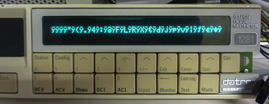
Image 3: Testing VFD display output and test connections
Teardown
Datron 1281 (and lesser brother 1271) using interesting arrangement for primary power supply with two big toroidal transformers. First transformer converts mains to low voltage supply for earth-referenced digital domain, and powers low-voltage PWM DC-DC around second transformer, with switching frequency in sync with mains.
Secondary outputs of this low voltage transformer are rectified and regulated with usual LDOs to provide clean analog supply voltages. What is the benefit in such double conversion? This design approach targeted to reduce capacitive coupling and keep power consumption by linear power supplies constant, so temperature inside meter’s chassis does not change in different conditions.
We already know, that temperature changes are our main enemy in high precision voltage and current measurements, so Datron had to make extra effort to reduce instability of temperature contributors, instead of adding fans or heat sinks around critical components. Similar idea technology was also used in Fluke’s 7000 DC reference standard and recent Keithley’s 7½-digit DMM7510.
Datron 1281 and 1271 are the using unusual arrangmenet for main voltage reference. Model 1281 using two identical Linear LTZ1000 based modules, labeled Datron 400763-1, with custom hermetically sealed Vishay metal foil resistor network, while Model 1271 using LTZ1000 module and LM399 module to save cost. In out units refereces were enclosed in black epoxy, and would be troublesome to remove from PCB for teardown.
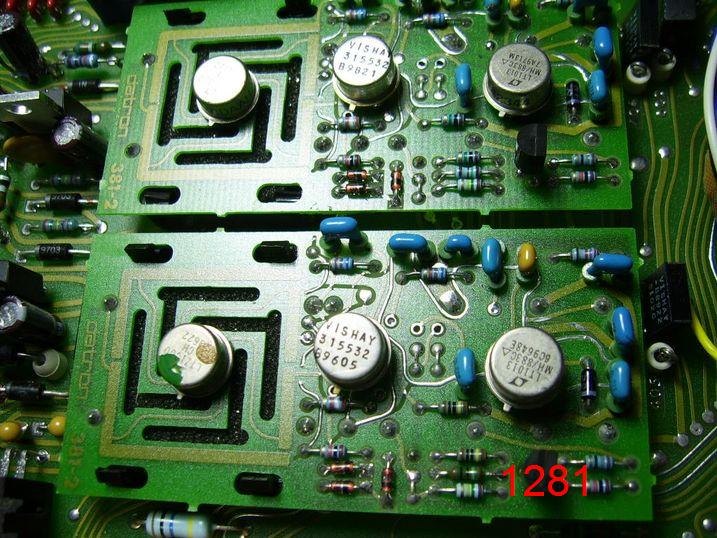
Repair workflow, unit #1
Unit was received as advertised. Meter was failing with error message 9005 – 00150C03 immediately after power on.
Service manual decode message for 9005 states : Serial Interface Fault.
While testing optocouplers with second Datron 1281, it was noticed that error codes were different on second meter if optocouplers were left out of circuit. Possibly one of the daughterboards was failing? A quick check of all cables to the main DC board showed one that was not connected and stuffed under the main board. Not good, as this shows someone was diagnosing an issue that required the board to be possibly removed from the frame.
After reconnection cable, this 9005 error code went away and first DCV readings were acquired. It looked good with the input shorted, however the OHMs readings were open. Another search for connector issues showed the input connector was hastily plugged in and had missed a pin on the DC board, pushing it aside. A quick reconnection and all the ranges appeared to respond as expected with the short on the input. A screw was also missing that held the connector in place.
A quick self-test gave what probably were the original errors, DCV ERROR 2182 DC 100mV range zero magnitude and NVRAM error. The errors are broken down based on the type of test. The Fast test failure code is explained in section 2.7.3 for True Zero Checks. It tests the mean value with the inputs shorted on the 100mV range.
Conditions are for test 2182 are : -250µV < Mean 100mV Zero < +250µV.
The NVRAM error is most likely due to a bad old battery, similar to what we already know from repairing old instruments like HP 3458A, scope CSA7404 and R&S SMT03. Good rule of thumb is to replace all batteries if instrument is older than 10 years.
Without further diagnosing of the error, the inguard and outguard supplies needed to be tested as the parts have datecodes from 1988 and the lithium backup battery is dated from 1987. Its voltage was measured at 3.7V which is pretty good for a nearly 30yr old battery.
The schematics for both the inguard and outguard supplies were scanned. Test points for the DC board were easily found as Datron did not use silkscreening on their boards and used unmasked copper for the TP numbers on the DC board. The Digital board, however, has no markings and does not match the component layout drawing in the service manual.
Neither boards have any REV markings on the top, but might be located on the bottom side.
Digital board
This PCBA have main meter’s brain, good old 16 bit Motorola HD68000P8 processor, manufactured by Hitachi. It’s indeed very popular chip, present in many instruments of those years, such as HP 3458A, Keithley 200x, etc. It is NMOS based 5V ASIC, specified to run at 8.0 MHz clock and able to address 16 MBytes of memory space.
There are multiple different versions of this PCBA for Datron 1281. Another kind of board is shown below:
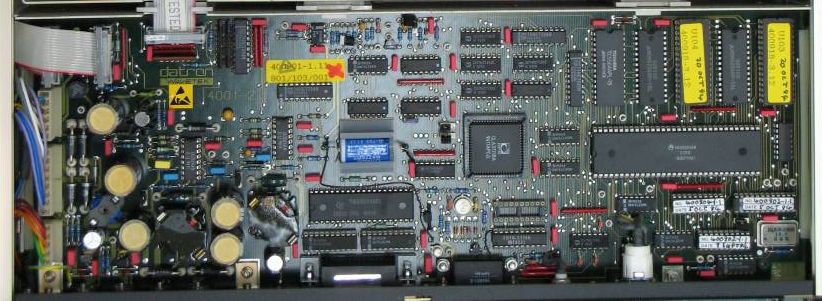
Image X: Digital board, courtesy of www.amplifier.cd .
Lot of 7400 series logic can be found around processor, having glue function for various I/O interfaces and control signals. All DIP-packaged ICs are replaceable, with using nice collet-type sockets. Re-seating all chips would be a good idea, considering age of the instrument and unknown history.
Other ceramic ASIC is located in center of the board, interfacing GPIB interface controller TMS9914ANL.
But first things first, power supply checks. The outguard supplies located on this PCBA were measured once suitable test points were found:
| Test point | Specification | Measured voltage | Ripple | Condition |
|---|---|---|---|---|
| +5V | +4.99 VDC | 0.32 VPK-PK | OK | |
| +45V | +47.1 VDC | 0.43 VPK-PK | OK |
The Digital board has four EPROMs that are stacked 2ea on a small piggyback boards. The part numbers show them to be Hitachi Semiconductor HN27512G-25, which are 512Kbit (64Kbit × 8-bit) UV or OTP 5V EPROMs. The firmware version appears to be 3.02 but will need to be verified through menus. The board plugs into a single socket and has an additional wire connecting to it marked A17 most likely for an additional address line to other memory ROMs.
The digital board is removed by taking out screws from the rear cover. The power supply and ribbon cables also need to be disconnected. The board and rear cover come out as one assembly.
(Picture showing which screws to remove)
All seven capacitors were changed with only one gotcha. Just like the DC board, one of the caps had a lead bent offset to line up with the PCB holes.
| Index | Quantity | Part Number on Digikey | Manufacturer Part Number | Description |
| 1 | 1 | 493-16250-1-ND | ULD1H100MDD1TD | CAP ALUM 10UF 20% 50V THRU HOLE |
| 2 | 2 | 493-6802-ND | UHW1E222MHD6 | CAP ALUM 2200UF 20% 25V RADIAL |
| 3 | 4 | 493-1622-ND | UHE1H102MHD6 | CAP ALUM 1000UF 20% 50V RADIAL |
| 4 | 1 | 493-1675-ND | UHE2A221MHD6 | CAP ALUM 220UF 20% 100V RADIAL |
| 5 | 1 | 493-1647-ND | UHE1J471MHD6 | CAP ALUM 470UF 20% 63V RADIAL |
| 6 | 2 | 1189-1869-ND | 25ZLH470MEFC10×12.5 | CAP ALUM 470UF 20% 25V RADIAL |
| 7 | 1 | 565-3939-ND | EKYB500ELL221MJ16S | CAP ALUM 220UF 20% 50V RADIAL |
| 8 | 2 | 565-3964-ND | EKYB630ELL221MJ20S | CAP ALUM 220UF 20% 63V RADIAL |
| 9 | 4 | 493-14725-1-ND | ULD1H101MPD1TD | CAP ALUM 100UF 20% 50V THRU HOLE |
| 10 | 10 | 399-15737-ND | ESL105M100AC3AA | CAP ALUM 1UF 20% 100V THRU HOLE |
| 11 | 1 | P19617CT-ND | EEU-EB1J101BJ | CAP ALUM 100UF 20% 63V RADIAL |
The lithium battery was replaced with a TL-5101P. Replacement of battery was performed with unit powered on and a battery powered soldering iron was used to avoid loosing calibration constants and SRAM data.
Here’s BOM list of parts used for repairs:
| Digikey Part Number | Made by | Part Number | Specification | Customer Description | Quantity |
|---|---|---|---|---|---|
| 439-1003-ND | Tadiran Batteries | TL-5101/P | 3.6V ½AA | 950mAh | 1 |
DCV board assembly
After disconnecting lots of cables and wires, main DC board was released and removed. Might be worthy to take a note of cable locations before removing PCBA:
Released board:
This colorful PCBA have all critical components for DC and main voltage reference modules, covered by black plastic covers. Unusual amount of transformers and inductors differentiate Datron’s approach in multimeter design. We will look into those later on, after repair.
Let’s check power rails from primary supply. Capacitors which should be replaced are marked on schematics in blue.
A quick test of the inguard supplies on the DC board showed the following values:
| Test point | Specification | Measured voltage | Ripple | Condition |
|---|---|---|---|---|
| TP901 | +15V | +15.0 VDC | 0.6 VPK-PK | OK |
| TP902 | -15V | -14.8 VDC | 0.04 VPK-PK | OK |
| TP903 | +35V | +35.4 VDC | 0.09 VPK-PK | OK |
| TP904 | -35V | -33.7 VDC | 0.87 VPK-PK | OK |
| TP905 | +5V | +5.0 VDC | 0.08 VPK-PK | OK |
All but two capacitors were replaced on the DC board (12 of 14). A couple of gotchas were found during the change out. The three 1000 µF caps had one lead bent offset to the bottom. It appears the mounting holes were too close together and did not match capacitor pin spacing. Another gotcha is that it is important to note which lead is offset as there are some components that will prevent it from going in properly. Two of the capacitors actually would touch each other and this is solved with the offset leads.
Another gotcha is that most of the four 100 µF capacitors leads are not soldered straight to the board. At least one positive lead is soldered to the pcb in through a pad but it is not usually shaped for the polarity (square-vs-round). The other leads are soldered straight to components with insulating sleeves. Two of these capacitors were relatively easy to remove by clipping them at the mating lead. The old lead was left on the part and the new lead was soldered next to it. There was concern that additional heat could have caused issues with the aging parts. The other two capacitors were surrounded by other parts preventing them from being changed easily. It was decided to continue troubleshooting at this moment and replacing them would have been done later.
The 470 µF cap was replaced with a higher rated voltage. The new part is as tall as the three 1000 µF caps. The lid has polymide tape directly above the three parts so the same precaution was added above the 100 µF cap.
The remaining capacitors had no additional gotchas.
An IET DE-5000 was used to measure the 1000 µF capacitors for value and ESR. The old parts were at least 20% below rated capacitance and the ESR was approx 1Ω @ 120Hz. In comparison, the new parts were all within 10% and the ESR was < 0.1 Ω.
Compressed air was used to clean the dust and debris from the DC PCB. The board was reinstalled in meter and the FAST SELF-TEST was performed several times over the period of several hours. All tests completed now without errors.
Here’s BOM list of parts used for repairs:
| Digikey Part Number | Vendor | Part Number | Specification | Customer Description | Quantity |
|---|---|---|---|---|---|
| 493-1647-ND | Nichicon | UHE1J471MHD6 | 470 µF/63V | 10000H/105 °C 7.5mm/sp | 2 |
| 493-1622-ND | Nichicon | UHE1H102MHD6 | 1000 µF/50V | 10000H/105 °C 7.5mm/sp | 4 |
| 493-6802-ND | Nichicon | UHW1E222MHD6 | 2200 µF/25V | 10000H/105 °C 7.5mm/sp | 2 |
| 732-9242-1-ND | Wurth Electronics | 860040778011 | 270 µF/63V | 10000H/105 °C 5mm/sp | 1 |
| 493-6817-ND | Nichicon | UHW1H221MPD | 220 µF/50V | 10000H/105 °C 5mm/sp | 1 |
| 732-9325-1-ND | Wurth Electronics | 860240578010 | 470 µF/35V | 10000H/105 °C 5mm/sp | 1 |
| 732-9281-1-ND | Wurth Electronics | 860240474005 | 100 µF/25V | 8000H/105 °C 3.5mm/sp | 4 |
| 493-14361-ND | Nichicon | UBT1J330MPD | 33 µF/63V | 2000H/125 °C 3.5mm/sp | 2 |
| 732-8966-1-ND | Wurth Electronics | 860020772005 | 1 µF/63V | 2000H/105 °C 2mm/sp | 4 |
Options
Now time for option boards, located on bottom side of instrument chassis
Option 10 – True RMS AC Converter
No issues were noted with the AC assy. It was inspected, photographed, and dust/debris were removed before it was reinstalled.
Option 20 – 2-Wire & 4-Wire Resistance Converter
After removal of Option 20 PCBA remnants of spider with it’s home was detected. That likely caused some excessive currents flow thru webs and poor bug, causing measurement issues.
No issues were noted with the Ohms assy. It was inspected, photographed, and dust/debris were removed before it was reinstalled.

Option 30 – Current Converter
Current shunt resistor network consist of separate set of resistors:
| RefDes | Value | Specification | Manufacturer |
|---|---|---|---|
| R111 | 800 Ω | 0.1% | |
| R112 | 90 Ω | 0.1% | |
| R113 | 9 Ω | 0.1% | |
| R114 | 1.0 Ω | 0.1% | Mann Components |
| R115 | 0.1 Ω | 0.1% | Mann Components |
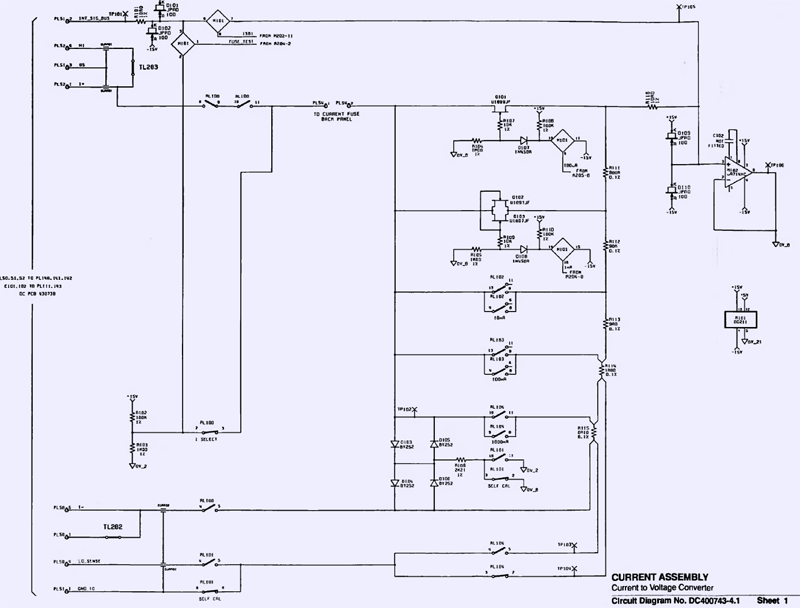
Pair of teal colored precision 4-wire shunts are manufactured by Mann Components Ltd (Ayton Road, Wymondham). Mann Components was an English resistor manufacturer with sales of about $2M. It was bought by Vishay in early 1983.
During reassembly of the bottom half of the meter, it was discovered that the Current assembly had some difficulty with the three connectors at the front of the pcb. Looking at the wires an interesting issue was found. It appears that the two outside connectors were placed in the opposite location. The wires are a little short and there is some noticeable stress. Looking for other photos on the internet, a ’94 era 1281 had the connectors located in the right position.
Other repairs
The lithium battery was replaced with a TL-5101P. The power was left on and a battery powered soldering iron was used.
The power input filter was also replaced as a precaution. The old part is a Waycom WF 120-3/05 and it was replaced with a Schaffner FN9222-3-06. The ground cable is exposed so additional heat shrink was added to the P and N terminals.
The power supplies were remeasured. All supplies are close to as-found except the -35V supply. It was now measuring -35.6VDC with 0.13Vp-p noise. The +15V supply measured 15.1 with 0.22Vp-p.
Quick check after assembly, with short on input terminals:
Input DCV +10V test:
Repair workflow, unit #2
This second unit actually happens to be the the first Datron 1281 acquired. It was chosen to repair last repair due to the number of errors.
The NVRAM in this meter is the same as the first 1281 but the battery is a few years newer.
Repair procedure is very similar to previous box. This unit comes with Options 10, 20, 30 and 70, so it have full set of boards and modules to play with.
This unit does not have mount hardware for 19” rack (Option 80) like previous, but comes with foot to angle it on the bench for easier operation. It is still older version of Model 1281, still carry Datron Instruments logo, not Wavetek-Datron like on newer meters.
Model 1281 is rare DMM providing separate active resistance guard terminal, unlike HP 3458A or Keithley 2002. Fluke 8508A have combined Guard terminal, switchable between passive or active mode.
Rear panel is same as first unit, with all the usual connectors and without any fans or vent holes. Keylock to enable calibration mode on this unit is damaged by previous owner, likely by attempts of using wrong key. This is rather unusual today to see such hard keylock to protect calibration, but back then it was easy go-to solution.
Of course it’s just single pole switch and any dedicated calibration pirate cannot be stopped by simple lock, as photo above able to indicate well. ROM/RAM chips have same style paper-written labels with version/serial number.
The fast self-test returned the following errors including test limits from the service manual:
| Error code | Limit min | Value description | Limit max |
|---|---|---|---|
| DCV 2182 | -250uV | Mean 100mV Zero | +250uV |
| Ohms 2752 | +0.01FR – 4% | Mean Magnitude | +0.01FR + 4% |
| DCI 2572 | -50ppm of FS | Mean Magnitude | +50ppm of FS |
The 2752 and 2572 test both use the Ohms 10mA current source. The current source was tested using Keithley Model 2002 as control meter. The 2002 showed a low noise source but the value was nowhere near specifications. Most likely the calibration constants are too far off.
It is hoped that the capacitor replacement will cure the DCV 2182 Error as it did on the first meter. The power supplies will need to be checked first, as usual with old equipment repairs.
Digital board
The outguard supplies were measured:
| Test voltage | Ripple on rail | Measured voltage |
|---|---|---|
| +5 V | 0.32 Vpk-pk | +5.02 VDC |
| +45 V | 0.23 Vpk-pk | +47.4 VDC |
The Digital board has firmware version 3.11 installed and is the same configuration as the previous meter with four EPROMs.
All seven capacitors were changed just like the first 1281 while observing if any of the leads needed to be bent to fit the holes in the pcb.
DCV board assembly
A quick test of the inguard supplies on the DC board showed the following values:
| Test voltage | Ripple on rail | Measured voltage |
|---|---|---|
| TP901 (+15V) | 0.1 Vpk-pk | +15.1 VDC |
| TP902 (-15V) | 0.06 Vpk-pk | -15.0 VDC |
| TP903 (+35V) | 0.10 Vpk-pk | +35.5 VDC |
| TP904 (-35V) | 1 Vpk-pk | -28.9 VDC |
| TP905 (+5V) | 0.08 Vpk-pk | +5.0 VDC |
The -35V supply is ~6V low and needs to be retested after cap replacement. The supply uses a standard LM337T negative adjustable 3-terminal regulator. Based on the DC Assy schematics, the -35V only goes to the Current assy.
All electrolytics were replaced except the four 100µF caps. After the first repair, it was determined to wait and see if the meter would still pass diagnostics based on the chances of damaging another part. It was noticed that the capacitors from both meters were the same make/model/value so it is likely they were original parts from around 1988.
Compressed air was used to clean the dust and debris from the DC pcb. Some cobwebs were also found around the power supply area. The board was reinstalled and the fast self-test was performed. The original three errors were gone, but a new error had been added from the AC assy.
This board features same jump-wired reworks and patches on bottom side:
Looks at all those transformers!
Option 10 – True RMS AC Converter
After capacitor replacement and reassembly meter throwing Error code 2512 : 1KV range which is related to AC board. Calibration on 100 mV DC range is off by ~2mV. It is measuring value through DC range, so it is a good possibility that offset on DCV measurement causing self-test for 2512 fail.
It appears that the diagnostic test for the failing step is low by 1.9 mVDC. It is supposed to be between 18.6 mV and 20.2 mV. I am reading 16.7 mV so gain loop of preamp is a little low or reference is low. Gain resistors were already measured and with shorted relay contacts to make sure they are working. Relays were also changed by previous owner so there must have been an “event” on the AC input side, which required repair/service of the unit. No signs of burning though.
Error 2512 was added after repairing Digital and DC assys. After going over all cable connections nothing obvious was found. However, after closer inspection, it was discovered that a couple of parts had been replaced sometime back in 1993. A couple of Mitel CLA parts and some reed relays all indicated that the AC assy had failed around that time. It also agrees with the EPROM firmware date codes.
The service manual includes diagrams of the circuit board parts involved with specific tests. It is also separated between the full or fast self-test. The “pathway” codes are included as well as how to select them. P076 is the pathway for test 2512. After recording several different pathway readings of full and fast tests, it was was the only test that was failing. The board was removed and inspected closer under magnification. A few solder joints on the board were suspicious and reflowed. The relays involved with the 10/100/1kV range preamp were reflowed as were the range resistors. It was also found that a plastic spacer that sits between the board and one of the standoffs was no longer in place. After cleaning a large amount of flux residue from the surface of the board, it was reinstalled and retested. All errors were now gone and a fast looptest passed after 24 iterations.
High-impedance signal routed thru array of 250KΩ high-voltage resistors with large cutouts in PCB to avoid leakage and capacitive coupling. It does not look good, but Datron engineers knew what they are doing.
Option 20 – 2-Wire & 4-Wire Resistance Converter
The Ohms assy was installed in the previous 1281 and a fast self-test was performed without errors. The board was inspected, cleaned of dust/debris, and photographed before it was reinstalled. No repair required here.
Option 30 – Current Converter
The Current assy was installed in the previous 1281 and a fast self-test was performed without errors. The board was inspected, cleaned of dust/debris, and photographed before it was reinstalled. No repair required here.
Front panel
No issues with front panel or display. It’s dark-gray color still with old Datron Instruments logo.
Other repairs
The lithium battery was not replaced. It is the same make as the first 1281 but an adapter board had been designed with FRAM so it was going to be installed in this meter first after it has been tested.
Paint on handles did not last well, having visible peeling now. There used to be magnets to keep handles locked in place.
The power input filter was replaced. Heatshrink was added to the P and N wires. Mains filter have soldered earth, just like in case with HP 3245A
The power supplies were remeasured. All supplies are close to as-found except the -35V supply. It was now measuring -35.3VDC with 0.11Vp-p noise. Just like the first 1281 nothing else had changed so it will be recommended that all supplies be checked even if the manual states they are not part of the affected assembly.
Quick check after assembly, with short on input terminals:
Input DCV +10V test:
Firmware
Firmware is stored in JEDEC-standard compatible ROM chips, such as:
- Hitachi Semiconductor HN27512G-25 DIP28
- ATMEL AT27C512 DIP28
| Firmware version | ROM1 U103, Part 1A | ROM2 U103, Part 1B | ROM3 U104, Part 2A | ROM4 U104, Part 2B |
|---|---|---|---|---|
| Model 1281, Version 3.02, Date 15-11-1988 | 1281 290159 CHK:0064A3A2 | 1281 290160 CHK:00B023DA | 1281 290164 CHK:0054F663 | 1281 290165 CHK:00AEE01B |
| Model 1281, Version 3.11, Date 16-6-1993 | 1281 290159 CHK:005CD06D | 1281 290160 CHK:00AD51DB | 1281 290164 CHK:004A7B3A | 1281 290165 CHK:00ACC784 |
| Model 1281, Version 3.12, Date 5-11-1996 | 1281 290159 | 1281 290160 | 1281 290164 | 1281 290165 |
Re-calibration after update 3.02 to 3.12 is not required.
Version 3.12 is also have faster self-test procedure with different amount of steps to run. Both meters show zero errors after tests.
Custom FRAM adapters and EEPROM programmer adapter
To avoid issues with battery, simple FRAM adapter board was designed and manufactured. Tested them using different bit patterns, without any problems. Also EPROM programmer adapter board was designed to allow read/write of the new modules for backing up calibration data.
To test correct detection and operation Datron/Wavetek 1281 with FRAM special test binary was created, in which constants were reset and only the serial number + line freq were written, to let meter initialize EEPROM. The FRAM board was read and then programmed.
The meter came up with no checksum errors. The serial number was still correct as was the line frequency, as expected.
Schematics clickable for PDF.
FRAM adapter:
GERBERs ready for ordering at ITEAD Studio are also available:
Datron/HP NVRAM FRAM adapter board
EEPROM programmer adapter:
GERBER:
EEPROM Programmer adapter for dual CE ROM chip
PCB prototype boards used for test:
Other possible issues
Block-diagram of serial communications data path from service manual can be handy to troubleshoot errors like 9005,9 pon tru/compl 001736. This 9005 series error usually means bad communication with one of option boards.
Jumpers LK704, LK703, LK702 can be used to bypass interface from optional boards to isolate and narrow down faulty module.
Happy meters now ready for calibration:
h2 Front panel damages
Front panel plastic panel mounted very tight and close to large fragile vacuum displays. It is held just by two small diameter screws on each side of the panel. If instrument lands on it’s face or get smashed in a corner VFD display is almost always destroyed even by a minor otherwise damage.
Our friend alm kindly shared photographs of his Darton 1281 in “as received” condition due to bad packaging:
When shipping any of the Datron instruments that share 1281 design, be sure to always overpack and protect the fragile front panel.
Tweaks and tricks
DIY cable for rear CHA and CHB ports
To utilize ratio mode custom cables for rear inputs are built.
Connectors are purchased from Digikey here and contacts like this or this or these depending on wire you are using.
Calibration
Calibration data is stored in U106 Toshiba TL5564PL-15 SRAM with Lithium battery backed up power supply. This is dual chip select (CE1 and CE2) 64Kb (8192 × 8 bits) 150ns CMOS SRAM, rated for +5V power in DIP28 package. Second chip select CE2 can be provided by inverting CE1 with external logic chip, such as 74HC00.
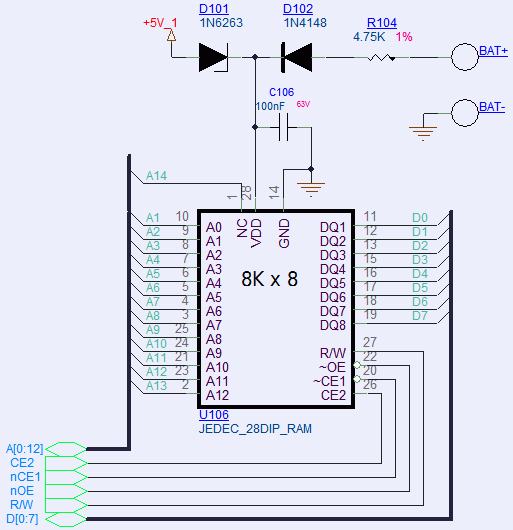
Performance verification
TBD
DCV Noise evaluation at shorted inputs
TBD
Restoration summary
Age difference between these Datron 1281 DMMs and more modern designs such as HP 3458A or Keithley 2002 is definately visible. Many bodge wires, reworks, hanging components from bottom PCB side, cut traces show amazing lot of debug and service on these instruments even after they went on market. Looks like these Datron/Wavetek 1271/1281’s are the most voodoo-intensive DMMs on the market with many custom today-obsolete components on every board.
It is even more amazing to see just few problems with both DMMs, most of which were resolved after simple capacitor replacement and reassembly. Hopefully they will continue to work few more decades.
This article would be impossible without Todd’s work, both units owner. All credits with discussion and raw content, photographs and testing go to him. Decision to make this article public was done to aid other owners of these precision multimeters from Datron. Also big credits to PeLuLe for complete service manuals, firmware v3.12 and his findings.
If you do have any questions, jump in comments! All the feedback is valued and can be added into article.
Projects like this are born from passion and a desire to share how things work. Education is the foundation of a healthy society - especially important in today's volatile world. xDevs began as a personal project notepad in Kherson, Ukraine back in 2008 and has grown with support of passionate readers just like you. There are no (and never will be) any ads, sponsors or shareholders behind xDevs.com, just a commitment to inspire and help learning. If you are in a position to help others like us, please consider supporting xDevs.com’s home-country Ukraine in its defense of freedom to speak, freedom to live in peace and freedom to choose their way. You can use official site to support Ukraine – United24 or Help99. Every cent counts.
Modified: April 23, 2025, 2:03 p.m.




